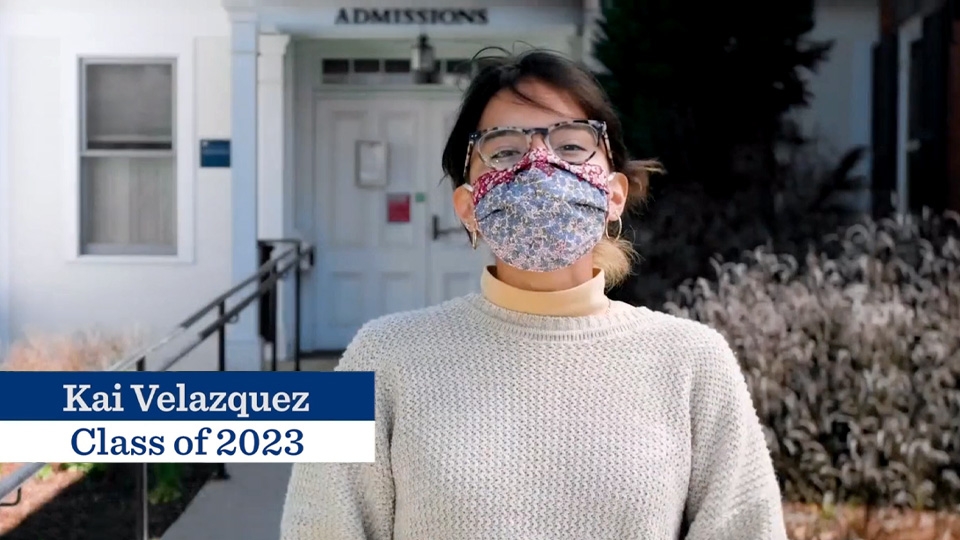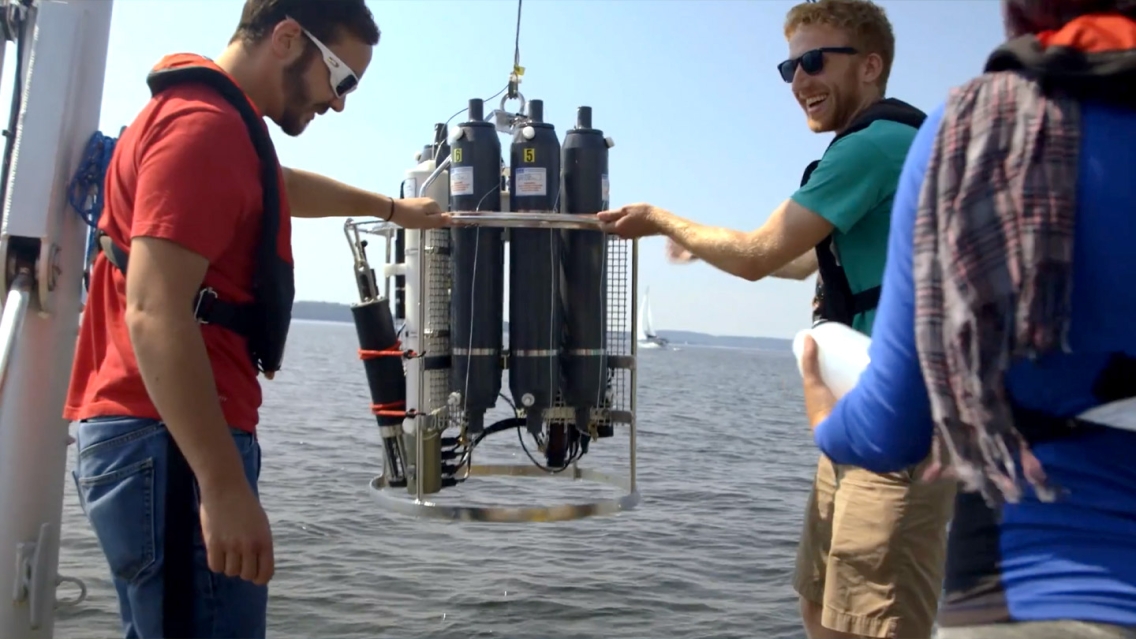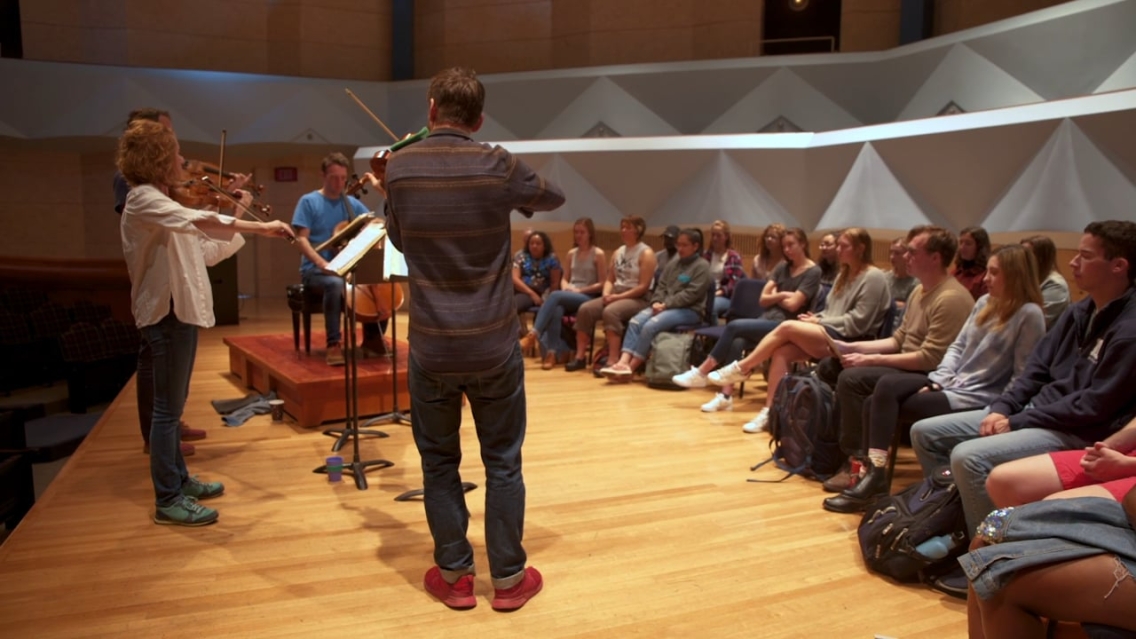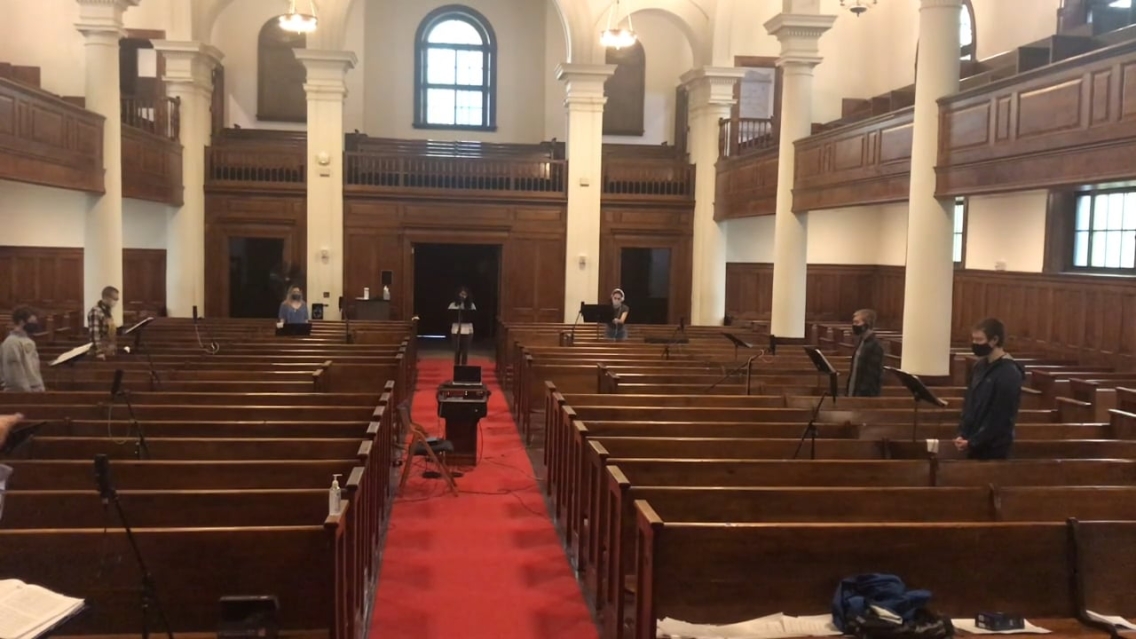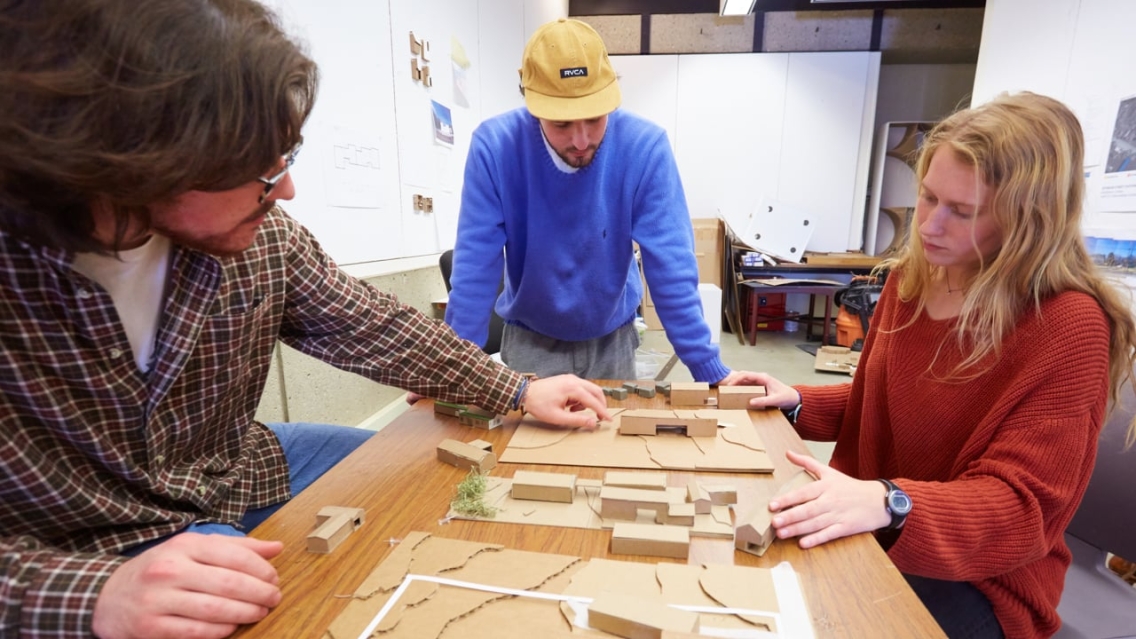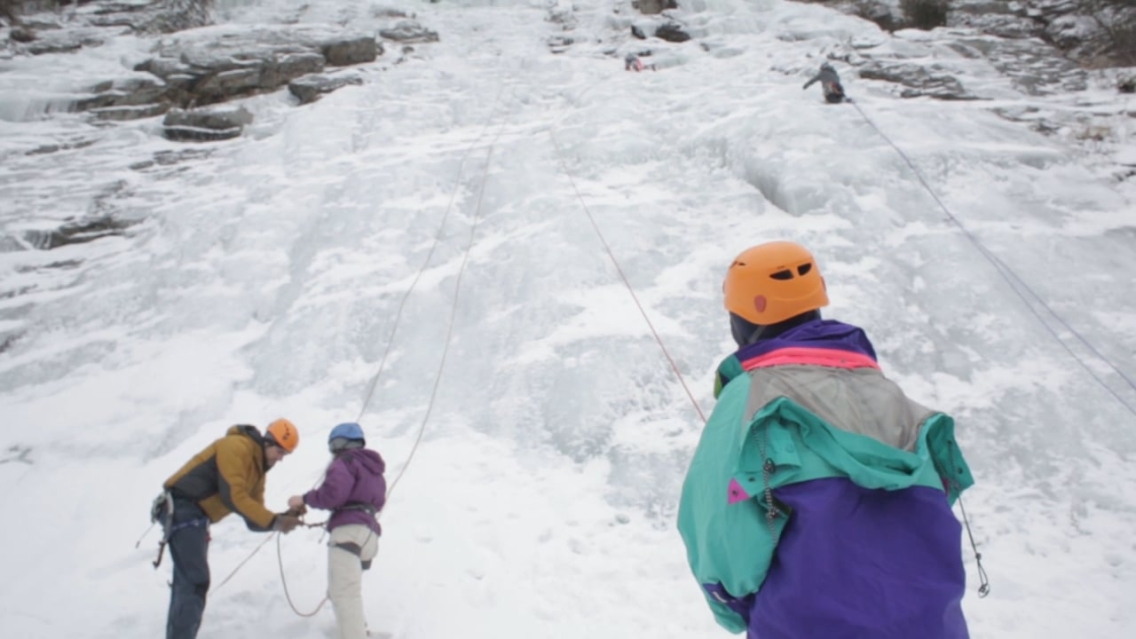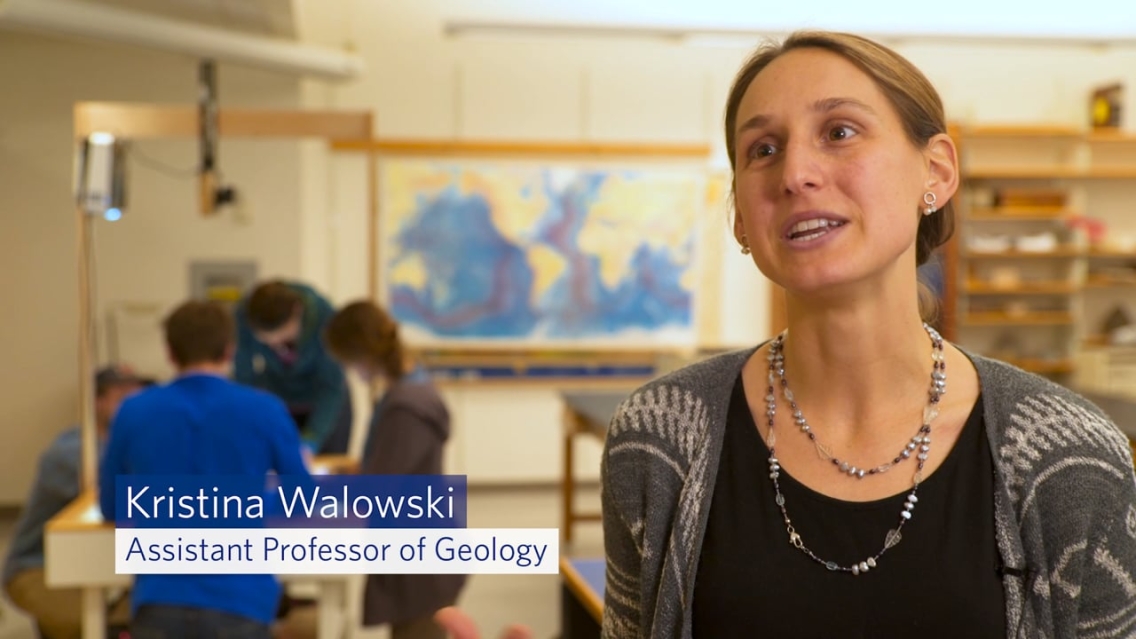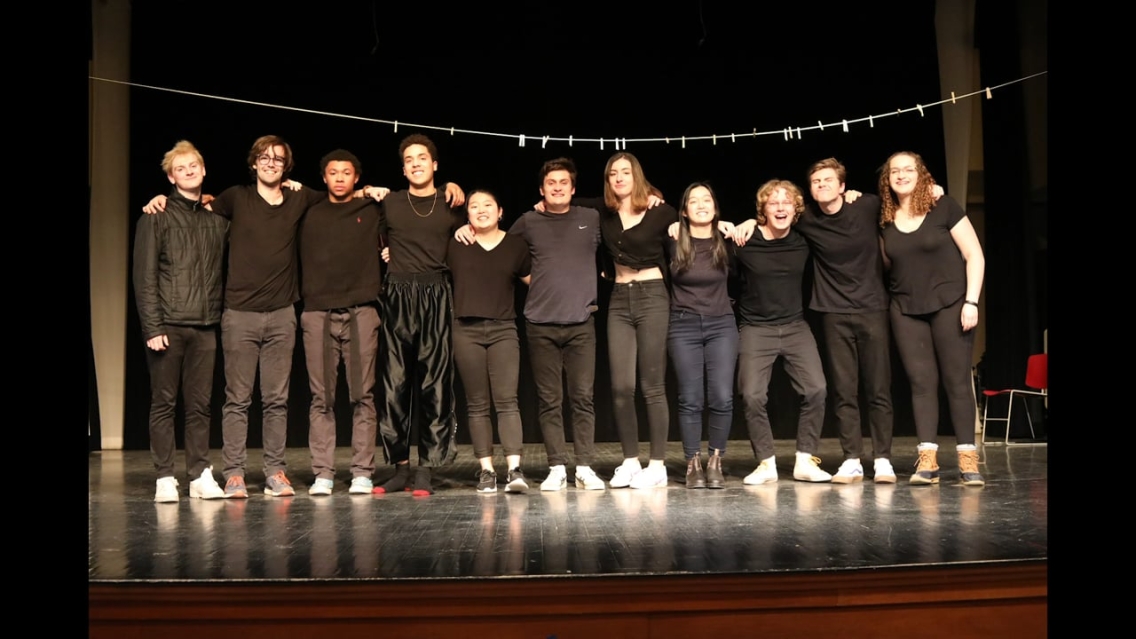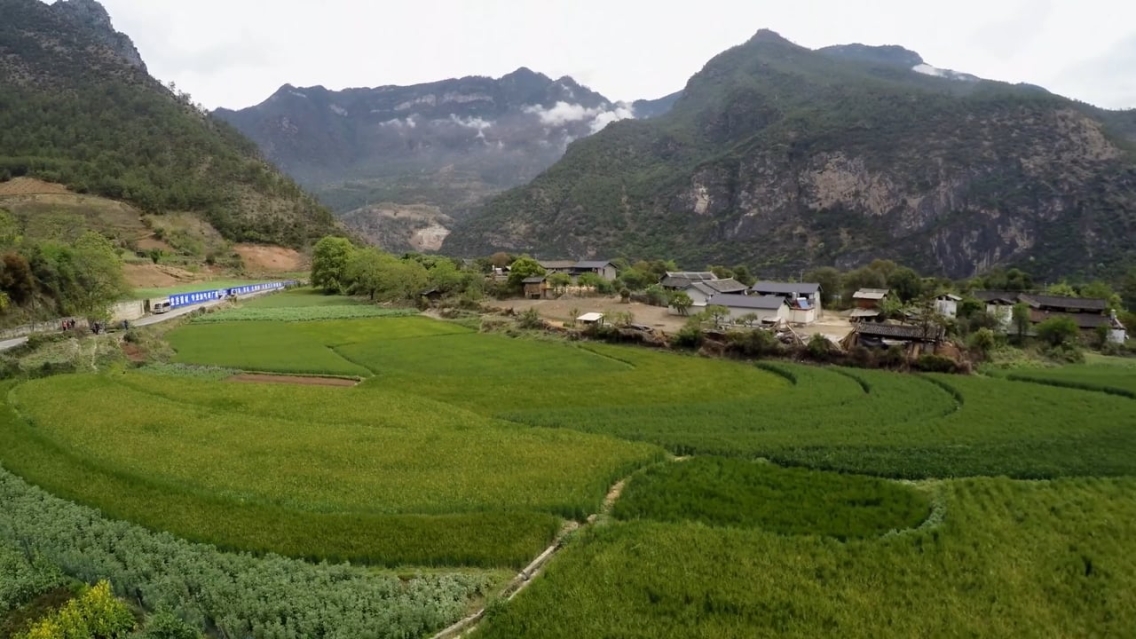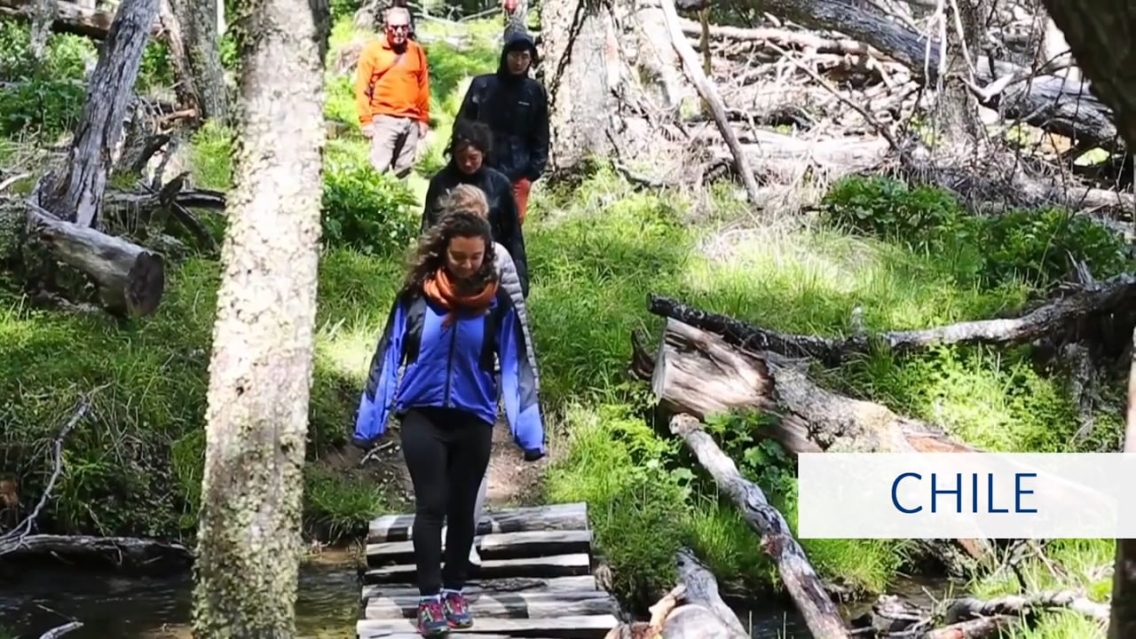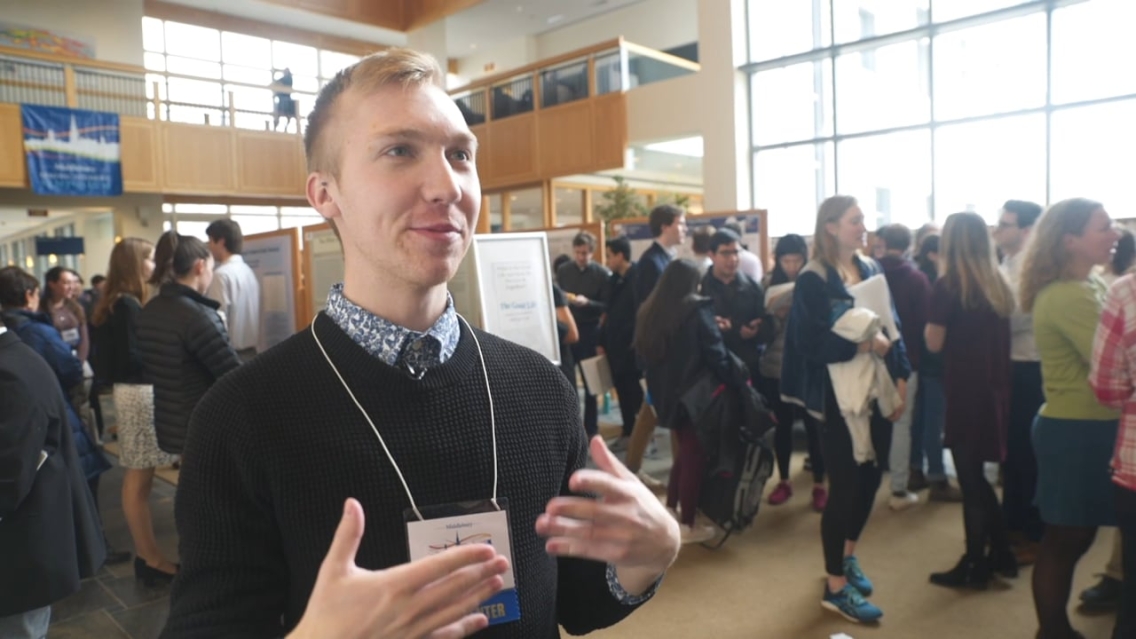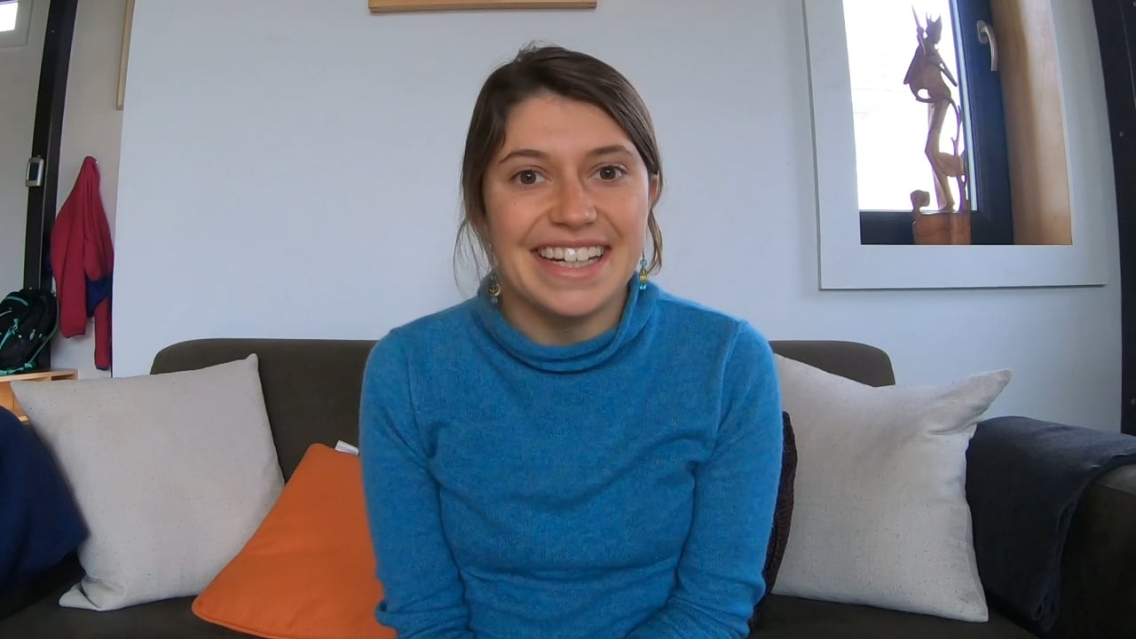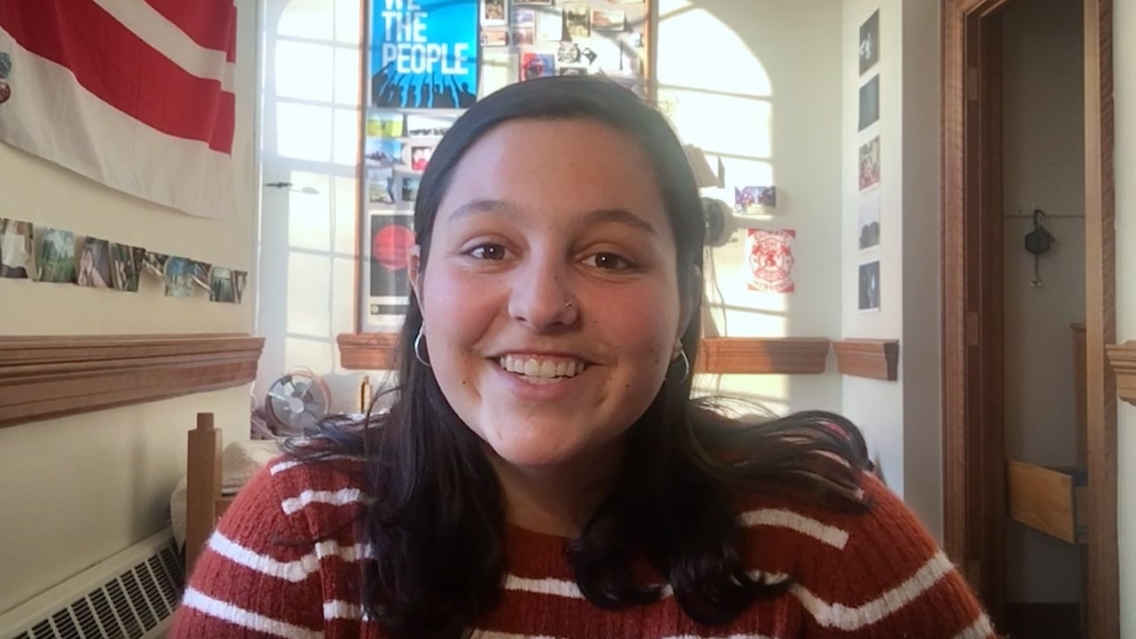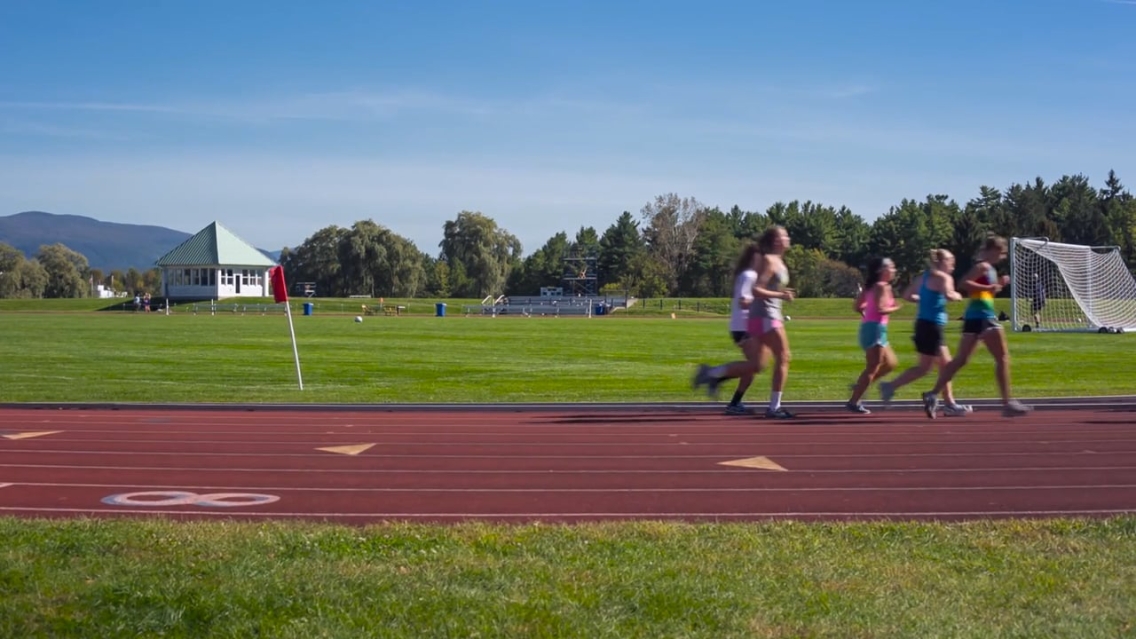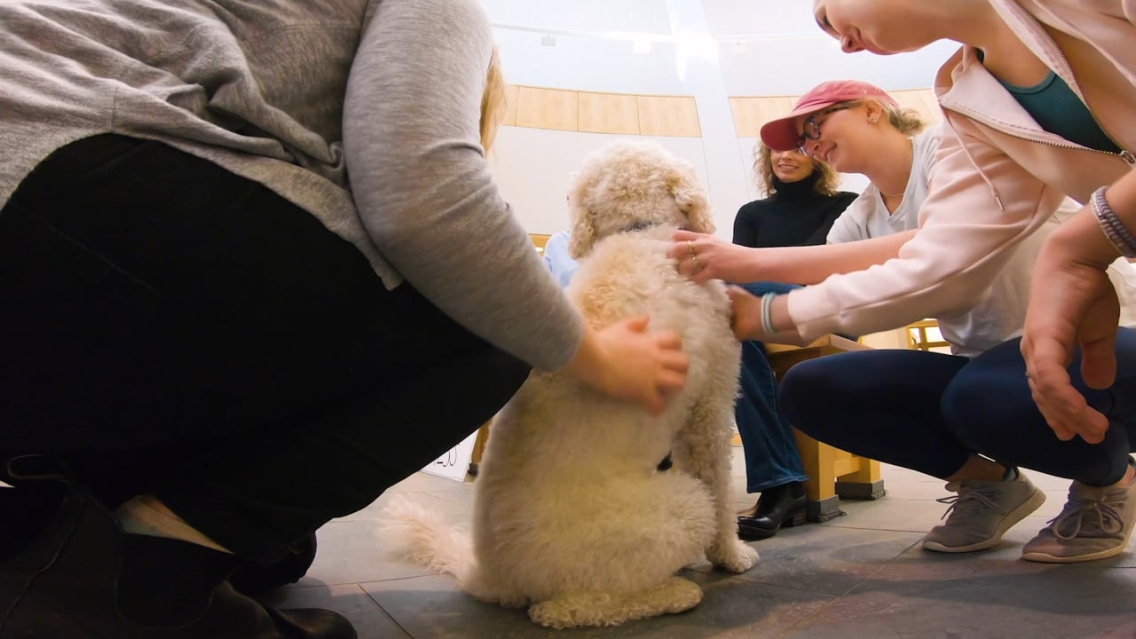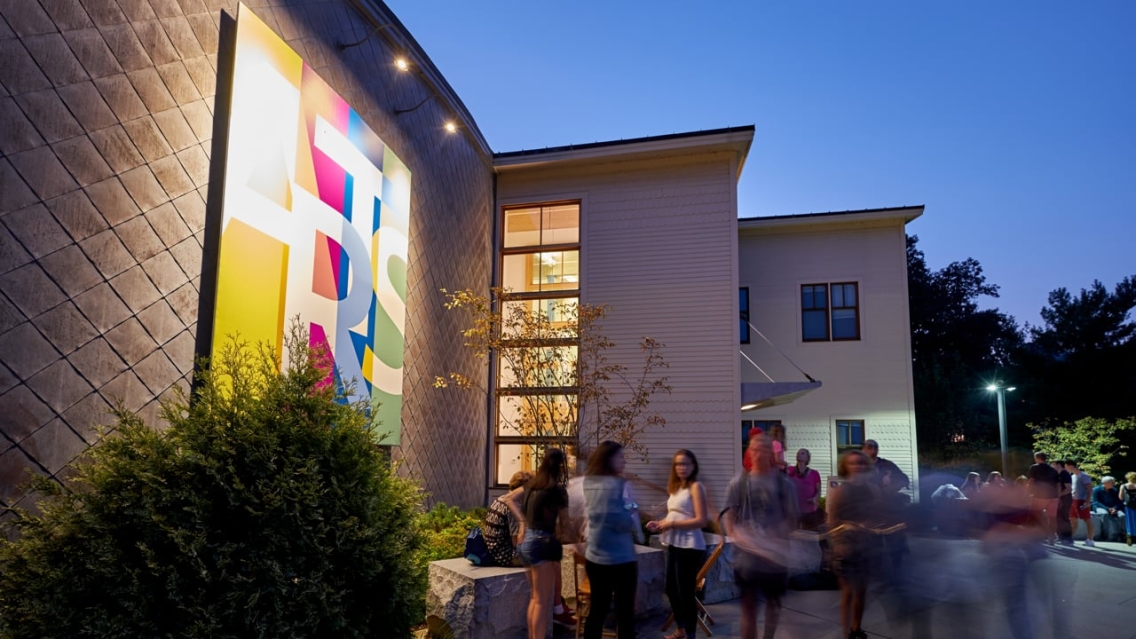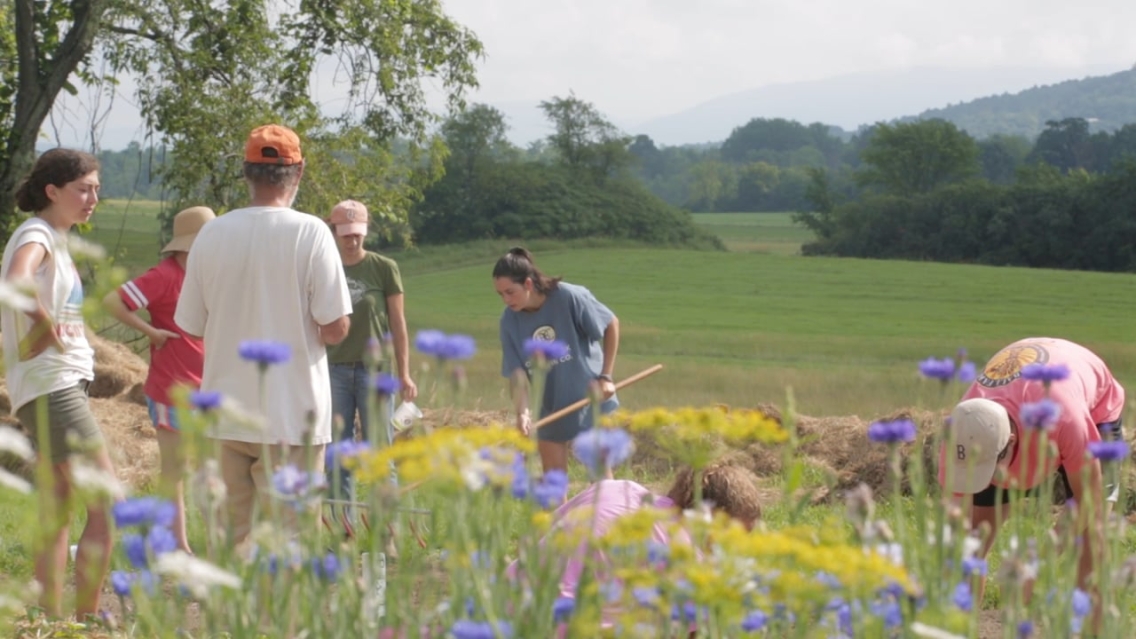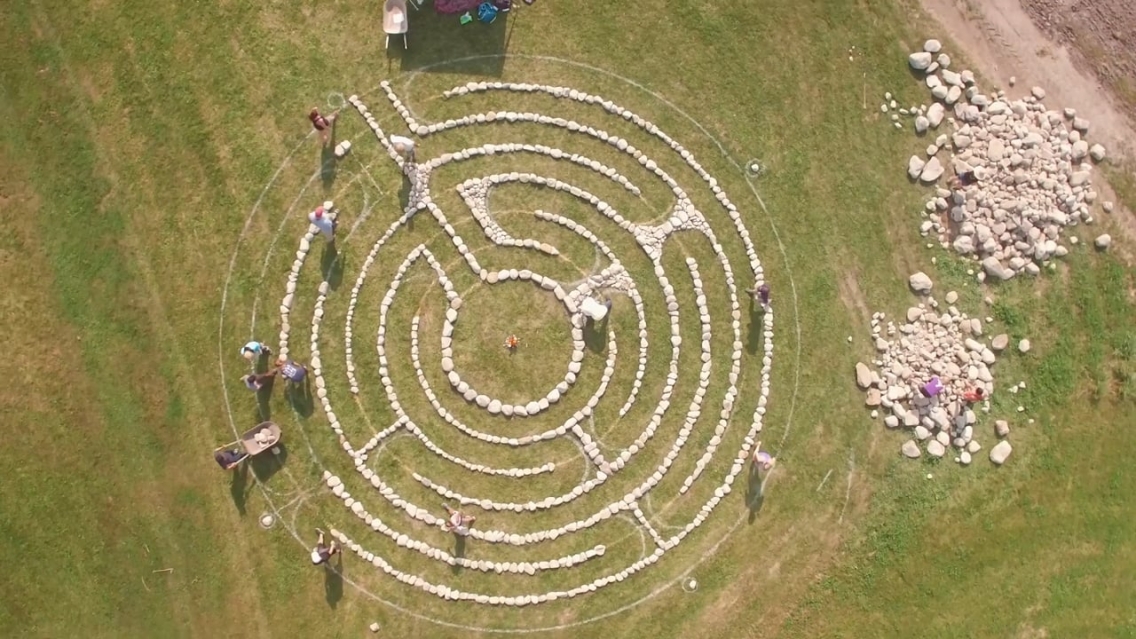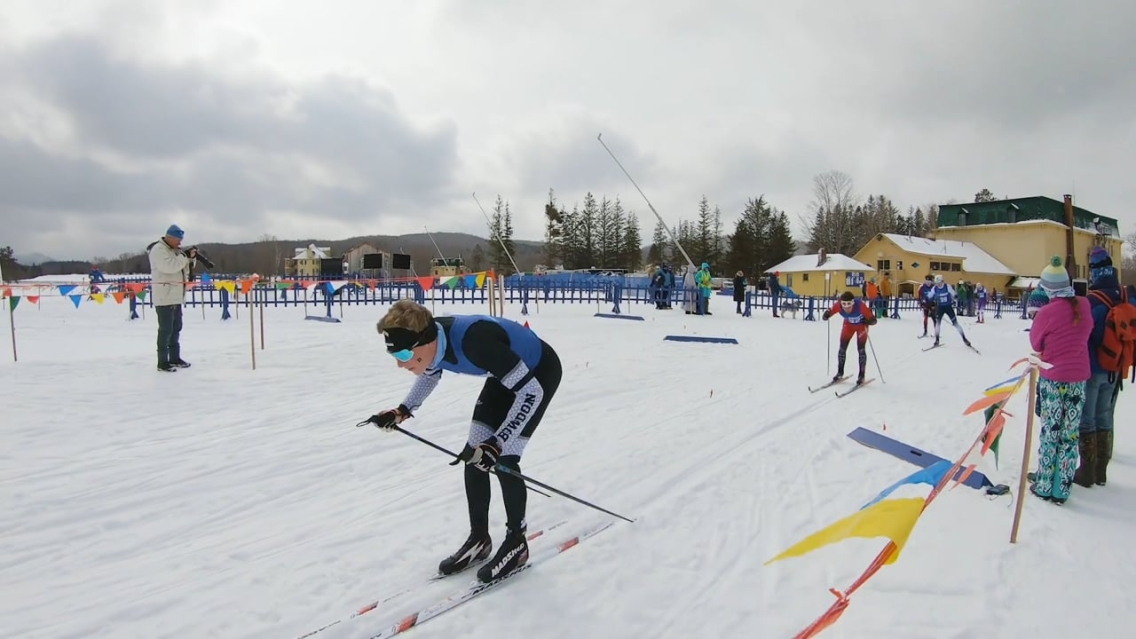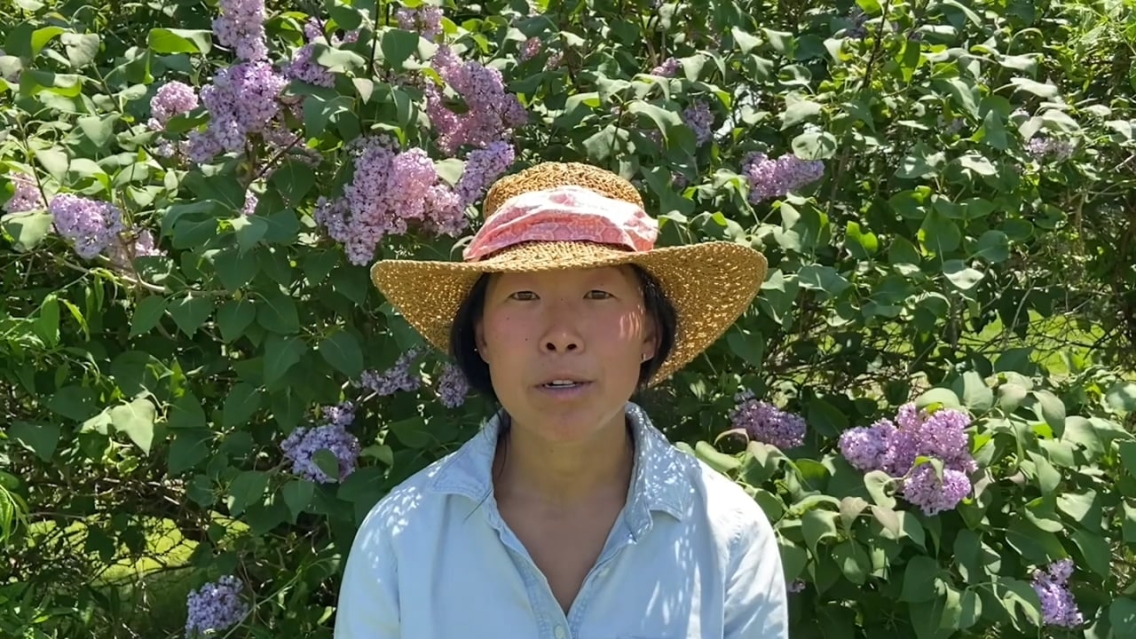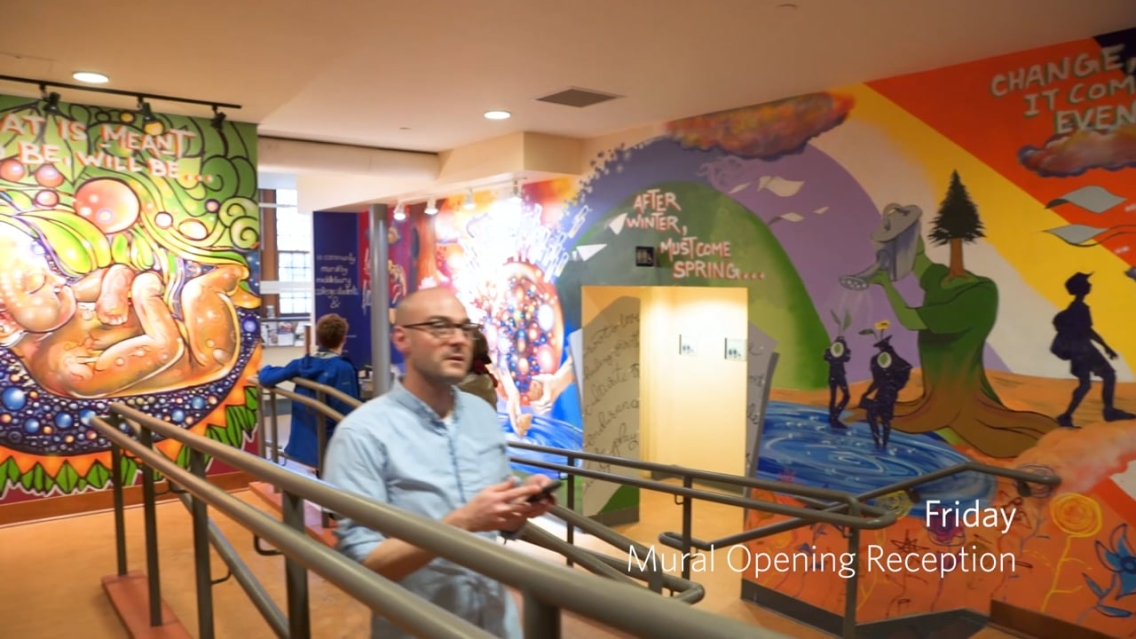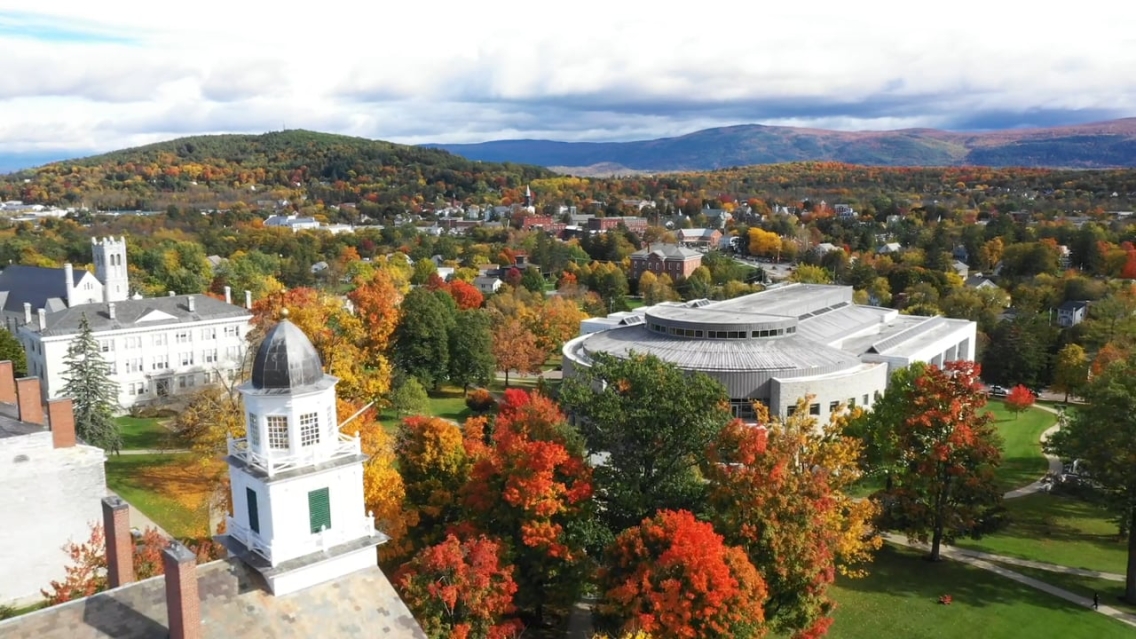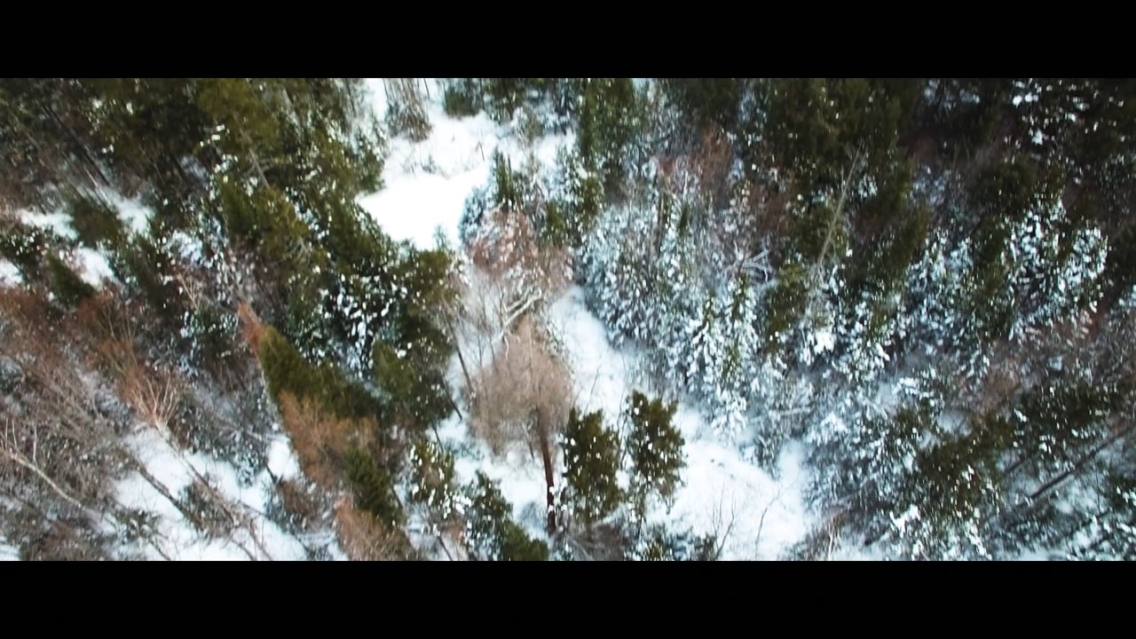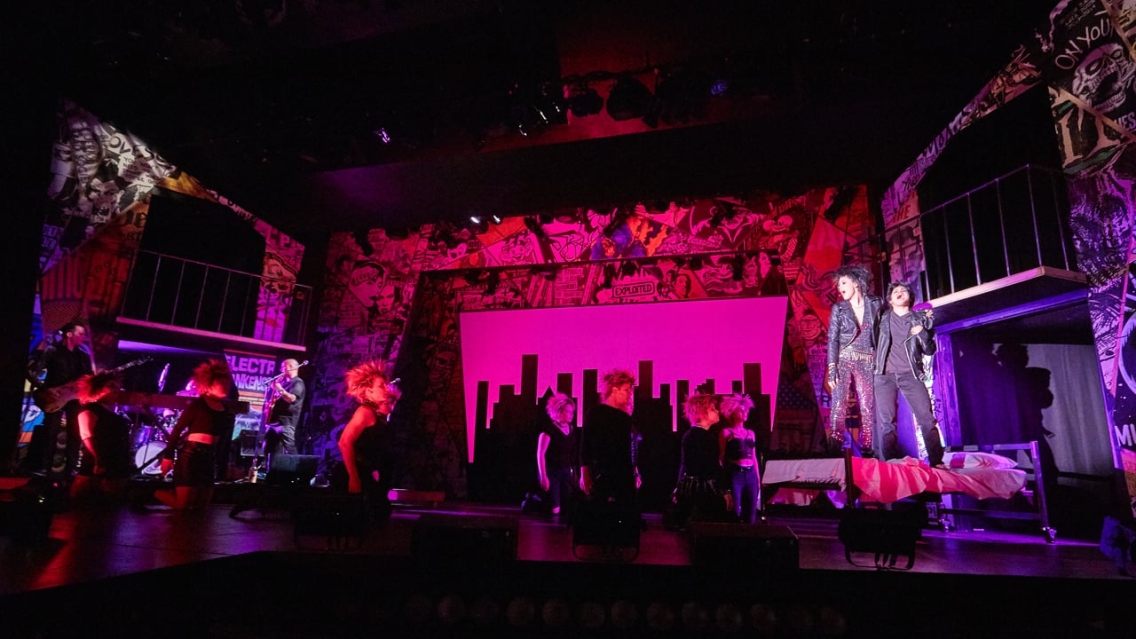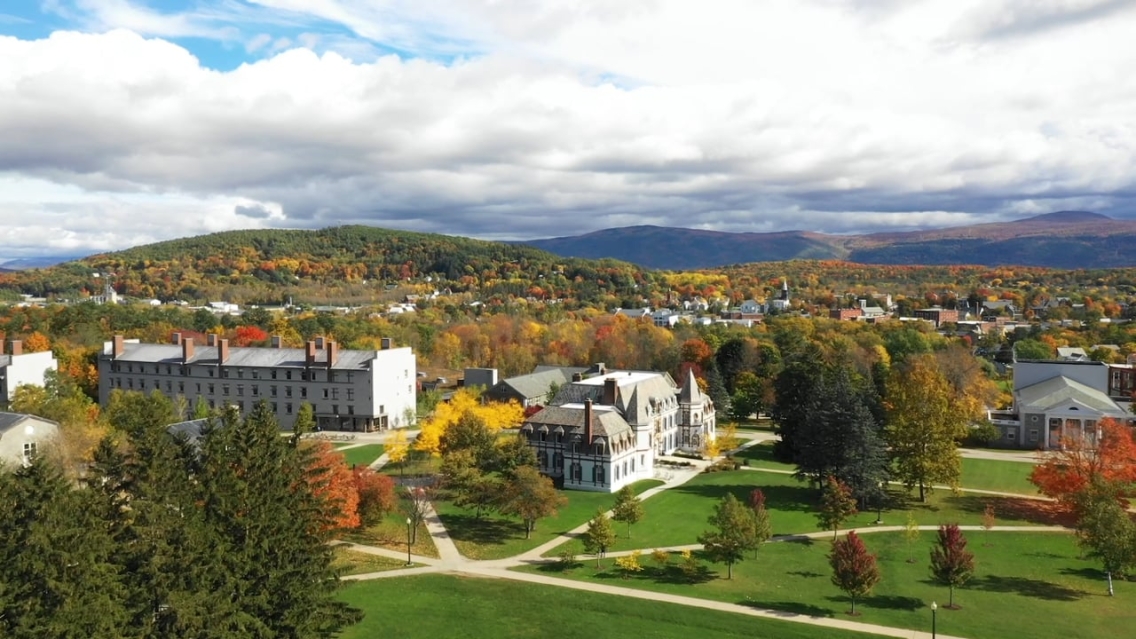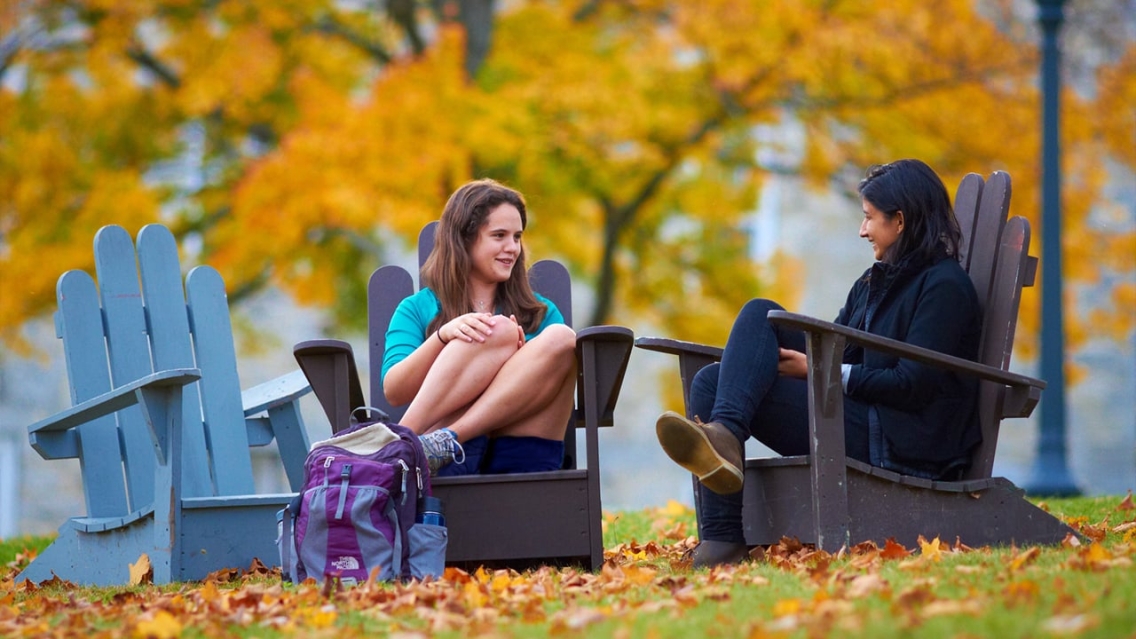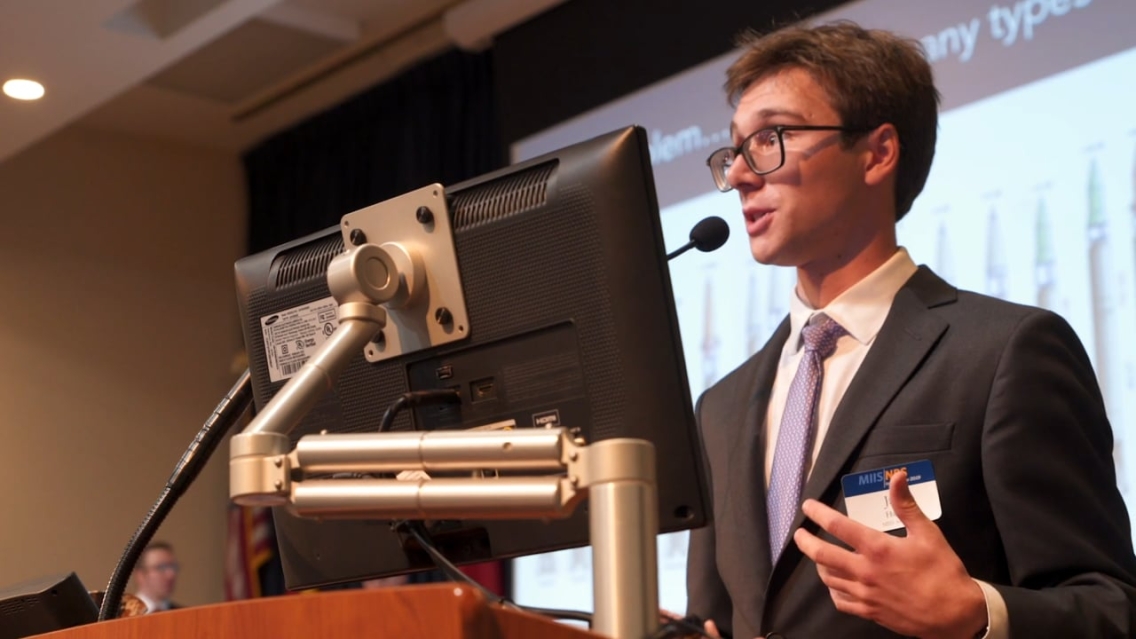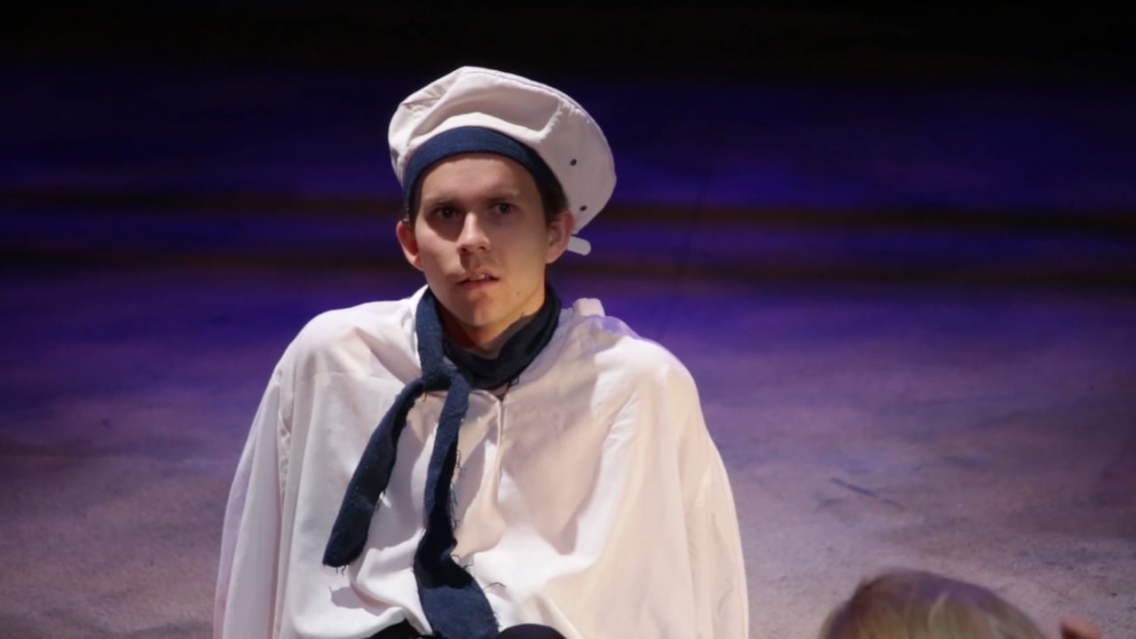Get to Know Middlebury
Middlebury College is a vibrant community with a history of progressive thinking, challenging academics, high expectations, and even higher outcomes. Get to know some of the people and places across our 350-acre campus that make Middlebury so special.
Middlebury Campus Tour
Take a tour across Middlebury’s campus, guided by students who share their experiences and insights as to what learning and living at Middlebury is like.
- Welcome to Middlebury College. Middlebury is located in central Vermont in the heart of Champlain Valley. From our campus, you can see the Adirondack Mountains to the west, Green Mountains to the east. Middlebury’s rural scenic surroundings help contributes to our tight-knit community while also offering opportunities for students to go out and explore. We’ll be giving you a short sneak peek into Middlebury’s campus and showing you some of our favorite parts of what Middlebury has to offer.
- The Axinn Center for Literary and Cultural Studies is the home of the American Studies, History, English and American Literature, Film and Media Culture Departments. This building stands out as it was constructed around our old Starr Library. This beautiful building is a popular study spot on campus, with students favoring the most distinctive rooms, the Reading Room and the Abernathy Room, which are part of the original Starr Library. This is the Davis Family Library and serves as Middlebury’s main library on campus. Middlebury College has over 1.1 million volumes in all the libraries and an online library catalog. Each of its three levels provide communal workspaces for students. It features the Technology Help Desk, where you can go for any tech issues that come up on campus. It also features the Center for Teaching, Learning and Research, also known as the CTLR. The CTLR is an academic center offering free tutoring across departments and support students on their research journeys. We also have a convenient cafe with a 24-hour study area. Davis is a campus hub to find academic support to collaboratively study and to find a place to relax. Ross Dining Hall is one of our three dining halls on campus. It is open throughout the day for all meals, with a nightly view of the sunset over the Adirondacks. The dining plan is unique in that all meals are prepared right here on campus, rather than by an outside catering service. You can eat in any campus dining hall, whenever you want, as often as you want. About a third of the food budget is used to purchase food sourced locally within a 250-mile radius of the College. We are also lucky to source local produce right here on campus at The Knoll, our student run organic farm. Middlebury students love the dining plan because it encourages students to engage in meaningful and lively conversations. It is very common to spend quite a bit of time in the dining hall, unwinding with friends, chatting with professors or practicing a new language at one of our language tables.
- McCardell Bicentennial Hall, more commonly referred to as Bi Hall, is our science center and home to all of our science courses. Armstrong Library, our science library containing all of our science volumes is here. One of Middlebury’s largest lecture halls with a max capacity of 147 students is also located in Bi Hall. The average class at Middlebury, however is 16 students. And even if a class is large, it’s usually broken down into smaller discussion or lab sections. These small class sizes really allow for students to be able to actively engage in their learning and to develop relationships with the professors who are passionate about their students’ success. Middlebury students conduct hands-on research as early as their first semester on campus in traditional labs or in the field.
- McCullough Student Center is a hub of student social activity. McCullough is home to the student mail room, where students have their own mailboxes, the campus bookstore and Wilson Hall, where we have concerts and performances throughout the year, ranging from roller skating to public forums. For a quick bite, you can stop by MiddXpress, which is our on-campus convenience store, The Grille, where students can get a variety of food items throughout the day, and even late at night, and Crossroads Cafe, where students can get different coffees, smoothies, and even sushi. McCullough is a central part of many Middlebury students’ experiences.
- The Mahaney Arts Center, known on campus as the MAC, is home to our Music, Theatre, Dance, History of Art and Architecture Departments. The center also houses three major performance spaces, the black box style Seeler Studio Theatre, the spacious dance theatre, and the breathtaking recital hall. Our Middlebury Museum of Art, a free admission art museum, is also housed in the MAC. It has a great collection of permanent and temporary exhibits in the 6,000 square feet of gallery space. Outside of the museum, Middlebury has an art and public places initiative, which buys public art fixtures and places them on all across campus. No matter what your level of art experience or exposure before coming to Middlebury, you’ll definitely be engaging with the Mahaney Arts Center.
- The Peterson Family Athletic Complex is the base for all things athletics on campus. Middlebury competes in the New England Small College Athletic Conference, or NESCAC, in 31 varsity sports. Inside, students have access to numerous spaces, including Pepin Gymnasium, the Virtue Field House, the Bostwick Family Squash Center, an Olympic-size natatorium, and a 10,500 square foot, split-level fitness center. Outside, the College of boasts its own ski mountain, the Snow Bowl, an 18-hole golf course, and over 50 kilometers of jogging and cross-country skiing trails, as well as acres of wood open athletic fields. Middlebury’s 350 acres of wide green lawns and rolling hills provide plenty of green spaces to get active.
- There are four first-year dorms located in our two campus clusters. They’re essential to student life and are your home away from home during your first year. Each hall is unique in their living arrangements, ranging in living accommodations from single dorm rooms to four-person suites. Each first year has an academic advisor, a Dean of Student Life, and a first-year counselor who helps support students joining our campus. After your first year, you have many options to explore a variety of housing, including living in an academic interest house, like one of our language houses where students speak in a target language as part of their residential experience. Thank you so much for joining us today. We hope you were able to learn something and we’re so excited to see you on campus.
Learn at Middlebury
At Middlebury, you’ll take classes across the liberal arts and sciences that emphasize personal instruction and collaborative, experiential learning. Apply your learning to real-world experiences here and abroad.
Science and Mathematics at Middlebury
Notice the red spots. It’s common name is the red spotted newt. And there is more biomass of this species in New England than of any other species.
By studying the sciences and math in a liberal arts context, Middlebury students receive a holistic education that fosters a deep and integrative approach to any field of study they choose.
Hi, I’m Steve Trombulak. I’m a Professor of Biology and Environmental Studies here at Middlebury College. Middlebury’s science and math departments blend the high tech facilities and cutting edge research typically associated with larger universities with a cooperative and intimate learning atmosphere of a small college.
Nowhere is this more apparent than in McCardell Bicentennial Hall. The 226,000 square foot building is home to its own science library, astronomy observatory, nuclear magnetic resonance spectrometer, animal facilities, greenhouses, and over 80 teaching and research laboratories designed for everything from astronomy to psychology.
Fairly big brain response, we’ve got some early indications that…
But for students, Bicentennial Hall is more than just a space for teaching and research. The four-story great hall and several study lounges teem with activity at all hours of the day with students from every discipline. The open study areas help foster the cooperation and cross-pollination of ideas that enrich both the experience of learning as well as its end results. The diversity of teaching facilities in Bicentennial Hall and Warner science hall show Middlebury’s combination of breadth and depth in scientific study.
One of them and then you look at the perp of that space, and you play the same game again.
Many students arrive here knowing that they’re generally interested in mathematics or science, but unsure of exactly what they want their focus to be. Far from being a barrier the academic structure of the liberal arts encourages students to try new subjects, make connections between subjects and discover their passions.
Shall I wait until he’s stepped off? Yeah.
With 11 departments and programs focused on math and both the physical and life sciences. Middlebury not only has a broad range of ways to study the sciences, it gives students the freedom to explore them all.
In addition to the many disciplines offered, the study and research opportunities here are first rate. From introductory lectures, seminars and discussions to intensive laboratory and field research. Students can experience a science curriculum in a number of different settings and even take the lead in their own education.
For example, we currently have students from psychology, biology, and neuroscience studying the behavior of octopuses through experimental research that they designed and are leading themselves. And recently our STEM innovation program brought together eight Middlebury students to address the issue of cyanobacteria contamination in nearby Lake Champlain. By combining their knowledge of molecular biology, chemistry, computer science, mathematics, and environmental science. The students designed an autonomous means of tracking levels of harmful blue green algae. The work done by these students was more than just an educational opportunity. It demonstrates the tangible benefits of a career in science.
The sciences and mathematics at Middlebury are a celebration of educational diversity. Big challenges tackled in small classes, learning spaces that are as social as they are studious. 21st century technology at the center of a liberal arts experience and 11 fields of study, each independent, yet each raising the others to heights they could not achieve alone. Through collaborative and hands-on study in a diverse array of settings, Middlebury offers an exceptional path to a world-class scientific education.
Art Meets Science
I teach a course this semester called Sensation and Perception. We’re really interested in looking at how does the brain generate our experience of the world? And so, last Thursday we had this really remarkable opportunity wherein we were able to take the class down to the Robinson hall and hold class with the Heath Quartet, and try to pair their musical expertise and some direct demonstrations of some pretty remarkable stimuli, if you will, with our course’s understanding of how the brain is then trying to take that information in and create our lived experience.
Going into the class, I actually had no expectation. I didn’t really know. This was the first time that we had had this opportunity to bring neuroscience students, psychology students, into a very different setting and work directly with the artists. The part that really struck me as the most wonderful was how both the students in the class and the musicians in the quartet understood their own limitations, in terms of what knowledge or information they independently possessed, and yet both had this unbridled enthusiasm to draw from each other, to have a more full understanding or appreciation of perception itself.
No one’s told you how to listen to this piece, but yet you’re picking out things that were important to the composer, he wanted you to hear.
But I also think it’s really powerful in the other direction, that Beethoven, without the neuro-biological understanding of sensation, can evoke the feelings that he wants, and that that information goes both ways.
There was something about the vividness of the perceptual experience that the live music was able to create, and help remind the students and myself that what we’re trying to explain, in terms of sensation and perception, is kind of a profound and magical experience, right? The musicians that were able to really emphasize the power that these perceptual experiences can elicit within us.
I’m often reminded by artists that we think we know what it’s like to see. We think we know what it’s like to hear, but in fact, so much of our perception is a creation in our own mind. One of the things that I love about art, broadly speaking, is the ways in which the artist can play with our expectations, to reveal to us ways in which our brain creates our experience of the world that maybe weren’t inherently natural to think about to begin with.
Creating during COVID
Speaker 1:
Together, (singing). Good. Listen, listen, listen, (singing). No space at the top. It sounds stick hockey. You don’t do that. Ready? (Singing). I think you can have a little bit more aggressive intent with it. It’s a little melody. One, two, (singing). What can we do to make that a four-bar phrase when there’s actually a rest in between the Soprano and Alto parts? What’s going to connect it?
Speaker 2:
The [inaudible 00:01:11].
Speaker 1:
And what can they do to make it connected?
Speaker 2:
Crescendo?
Speaker 1:
Crescendo. Let’s do it. One, two, three. Here’s one, two (singing). Careful, careful. Could we do that with Sopranos and Altos once? One go. Bingo, everybody. One, two, (singing). That’s really nice progress. Does it feel good?
Speaker 3:
Yes.
Speaker 1:
Okay. Let’s carry right on into the [inaudible 00:04:00].
Designing for Real
John McLeod:
Now imagine these rafters, this whole assembly is sloping down and up, right? We’re cutting [crosstalk 00:00:05]… The partnership between Middlebury College and Habitat for Humanity in Addison County came about when Ashley Cadwell, who’s an alum of Middlebury, had this idea for Middlebury College architecture students designing the houses that the local chapter of Habitat for Humanity would build… Who’s doing foundation? You guys were, so that’s the interior.
John McLeod:
It sounded really intriguing and appealing, because, of course it’s a chance for our students to have a real world experience and to go through the whole process that an actual architect experiences… What we want to look at is, in terms of dimensions, and getting the backup turnaround that’s required by the town, how do we lay that out?
John McLeod:
The one caveat that I put on the potential partnership was that it had to be a good design experience for the students. It couldn’t just be the easiest thing to build. It, in fact, had to engage them in a thorough, and fun, and inventive design process. And Habitat, to their credit, they were game and they agreed to that. So I sat down and crafted the best way to lay out the courses and structure them in a series, or a sequence, that would allow us to take the process all the way through.
Emma M.:
These are all the different things we’ve been researching and we have been [crosstalk 00:01:25]-
John McLeod:
Okay.
Emma M.:
… sizing.
John McLeod:
So there is [crosstalk 00:01:29], yeah.
Emma M.:
We just need to organize it more. But we’ve been… When we first began the project, I think knowing that it was a real world project drove the whole design process. So when we started out, we did propose individual approaches. But it quickly became clear that no personal agenda or design idea could be decided. It all came out of what the site was asking for and how these families would occupy these homes. It was clear that this isn’t just a class for a grade. And the difference between forgetting to put in a stud in a wall is whether the house is built or not. It’s not the difference between an A and a B.
Calder Birdsey:
A lot of people would ask me about the class and say, “How are you graded? You don’t really have any assignments. You don’t have to worry about due dates.” Which I would always struggle to respond to them, and say, “It’s not like that. We have this common goal, and none of us really know how to get there. And we’re all kind of figuring it out, as undergraduate architecture students, and learning along the way.”
John McLeod:
I realized when I was planning out the design process in the studios that I really had no choice but to approach it as I would approach a design project in my private practice. Except, the big difference was, instead of one or two of us in the office working on it, I had 14 students, plus myself.
Speaker 2:
This assembly here has a high drying potential. This thing has nothing between it and some very dry outdoor air.
Emma M.:
I think in typical studios, we never get past just the design process. So having to think about codes and permitting was obviously very challenging, especially in the second semester, doing more of the technical work.
John McLeod:
Yes. All right, it’s just this whole thing has to slide up here, which means there’s not room for the parking… Every possible challenge on a project, I think, cropped up during this one. And while difficult in the moment, it was also an incredible opportunity for students to get the full experience. Certainly one of the more challenging aspects of the process was meeting with the Development Review Board at the end of the spring term. They’re actually the body that has the authority to approve or not approve. It’s not uncommon to not get through DRB on the first pass. And we didn’t, in part, because we had some challenges with the size of the lot.
Emma M.:
The town was definitely a little surprised when we proposed to have detached homes, but I think they’ve always admired our goal of having two families, being able to be located close to downtown, in two affordable homes.
John McLeod:
There was a bit of drama there, because we were actually a couple 1,000 square feet short. We had to make sure we complied with the zoning requirements for being able to build two houses on one lot. And over the course of the summer, we were able to negotiate with the land owner to our west, who agreed to convey enough square footage to the lot to enable it to become, as of right, compliant. So then, that set us up to go back to the DRB in the fall semester.
Calder Birdsey:
One of the things that was kind of eye opening for me was to see just how many hoops we had to jump through and, as an architecture student, understanding how complex it really is to get a lot of things done… So one of the things had been mentioned in spring was the holding of the front street edge, and this relates to the changes presented to you last but I just wanted to reiterate that the residents, A, will be holding that front street edge as it’s set by the neighbors to the north and the south… When we finished in the evening, we didn’t know what their ruling was, so we had to wait several hours. And that was a point in the project where we had to reconcile the fact that a lot of the work we did might not actually be completed or reach its final phase, and that was just a fact of the project.
DRB speaker:
Next item is the application by Habitat for Humanity of Addison County. All in favor of the motion say, “Aye.”
DRB group:
Aye.
DRB speaker:
Opposed? All ayes. The motion’s cleared. Other business?
John McLeod:
The Development Review Board was a real board with real authority. So for the students to be able to go through that and make a convincing case, that was an incredible opportunity… I just want to say, I think this is such a win, win, win. You know, for Habitat, we’re getting diligent, thoughtful, and appropriately progressive design of affordable housing in Addison County, which is fantastic. So I just want to thank the students for your great energy and participation. And Dora and family, I hope you enjoy your house for many years to come.
Speaker 3:
The ground is broken.
Calder Birdsey:
To be able to participate in the schematic design, in the design development, and in creating the actual construction documents, and then actually getting to have the hands-on experience of building it, is just so, so rare for so many students.
Emma M.:
The most rewarding part of this project for me was getting a chance to meet more locals in the community and also make a project that the community would want.
John McLeod:
On budget, on time, and to the satisfaction of the client and the user, and to do something sensitive for the environment in the process, it’s like no opportunity I know of. And I’m really excited and looking forward to being part of it into the future.
J-Term: Focus and Fun
At Middlebury, we have a one semester in-between term that we call winter term, or J-term for short, and it’s this one month little period, so just 20 weekdays of class time, when students enroll in a single class that they have the opportunity to focus on intensively for that one month.
My name is Ted Grace. I’m class of 2018, and I’m majoring in biochemistry and molecular biology. I’m taking adventure writing, which is in the creative writing department. I have the really incredible opportunity to go out into Vermont and essentially document an adventure. And I’m actually doing a Olympic biathlon.
I love J-term. It’s kind of an experience that you get in one month that you could never get in three months. It’s much more intense, and so their interest and their passion develop at heights that they wouldn’t normally get in a regular semester.
The students are totally focused, because if you compare the J-term to, for example, any other semester, they have a lot to do. I could really notice that there was a remarkable progress in the students’ language competency.
I’m Caley, I’m a sophomore, and I’m an IGS East Asian studies major. I’m taking writing the body. It’s a dance class. It’s called contact improvisation. It’s a duet dance form, and you are in a space with one other person, and then you have this rolling point of contact or point of touch, and you respond to what they’re doing. And you make decisions about what you’re going to do, and you move together.
The student body are all non-dancers, so they’re all people coming in with no real experience moving, or dancing, or improvising, or even making art. Because they’re not dance students, the January term gives an opportunity to really explore something that is outside maybe their comfort zone, or maybe it’s something a little bit new, something that they want to bring into their other studies.
I feel J-term gives me a chance to explore the new field I have never tried before and take some risk, and I feel this it’s a very good chance for me to use my photography background and apply what I learned from architecture to this class. ♪ Understandable ♪
My name’s Kahari Blue. I am a first year, class of 2019. So this J-term I took the American musical in performance class. So pretty much the first three weeks of J-term we put on a full-scale musical production, and I thought it would be really cool just to focus on my work for a whole month. Typically, I’m used to doing theater as like an extracurricular thing, so it’s really cool to just like focus on that for a period of time. And it kind of showed me what it would potentially be like if I were to go out in the real world and be an actor.
I think that Middlebury is justifiably well-known for our academic programs, but we have amazing co-curricular opportunities, as well, and I think that the winter term workshops program is a great example of that. It’s an opportunity for folks to try something new in a setting where there are many such opportunities. There’s everything from blacksmithing, ceramics, outdoor education opportunities from dog sledding, to ice climbing, to winter hiking, you name it. There’s a huge variety. What I hope they take from these workshops is a new experience and just a renewed curiosity to try and go out and find other new experiences.
To be able to be here at Middlebury with all your friends studying something you’re really interested in, it really brings this highbrow academic place to a real, you know, a place you can really live in.
The people that the college brings in, they represent such a broad spectrum of careers and opportunities and lives, that it’s great exposure for the students to meet all these different people. And I think it just takes it a little bit outside of that rigid academic environment, and makes it a little bit more personal and really kind of enduring in some ways. I mean, I miss my students already, and I hope we keep in touch.
J-term in my eyes is one of the most incredible things Middlebury has to offer.
Midd kids are so busy and so involved, and so like every second of your day, there’s things you’re supposed to be doing. And there’s some unregimented time during J-term where you can explore things. Everyone’s so willing to like try crazy stuff and go on adventures and hang out with friends.
When I go home I honestly don’t feel like I’m recharging all that much. It’s a whole different world. But being able to be here at Middlebury, it makes the next semester of work and all these four classes a lot more palatable. The things I really want to focus on at school, or finally have an opportunity to focus on, I’m doing and learning.
When it’s over, the students are proud of the depth with which they’ve gone exploring a particular subject.
I’ve spoken to a lot of students who say that they’ve they’ve learned more about themselves and what they want to do with their career during J-term because it’s a chance to really step back and to think about what’s important to you and also just have an incredibly amazing time.
Technology across the Disciplines
Kristina Walowski:
So the Augmented Reality Sandbox is a teaching and learning tool for geology and geography, and it’s a great way to teach about landforms, and topography, and geologic process.
As the students manipulate the sand, what’s happening is the X-Box connect radar is constantly scanning the sand. So as the students manipulate it, every time it picks up those changes it’s sending a relaying that information into the computer, the computer projects it in that false color image related to topography.
With technology being so pervasive, it’s important to use technology in the classroom as much as possible. But, technology specifically like this, is also really engaging. It’s really colorful, it’s really hands-on. And so even though the students are learning about topography and maps, which can be really dry, it’s a really memorable experience.
21st-Century Theater Festival
Speaker 1:
What was Macbeth asking?
Speaker 2:
Have you recovered my lady? Ah! What joy.
Speaker 1:
What was he asking?
Speaker 3:
Ah! My lady, you shouldn’t meddle in affairs that are Macbeth’s alone and Hell’s.
Speaker 1:
What? And Hell’s?
Speaker 3:
Heaven’s I mean.
Speaker 1:
And between Heaven and Macbeth, what role do you play?
Speaker 2:
Hell.
Speaker 4:
I am innocent of that action because my power did not command it. I already know how to speak like you Macbeth, don’t I deserve a reward? Shh, shh. I only have your name.
Global Partners for Sustainability
Mahli Knutson:
It’s a tall order to presume to contribute to the sustainability of the country where a Middlebury student studies abroad. But that’s exactly what the Global Partnerships for Sustainability or GPS is all about. It provides an opportunity for students to contribute, even if in a small way, to advancing sustainability in the place where they study. Students work with in-country partners to help them achieve their sustainability goals. A few examples include, helping the Nature Conservancy of China shift a local economy in China from intensive bamboo farming, to designing and marketing bamboo arts and crafts to protect a drinking water supply.
Or working with the Wildlife Conservation Society of Chile to help develop plans for a new national park in Tierra del Fuego. In my own case, Middlebury students traveled from Tokyo to Tottori to participate in a lumbering project with the goal of bringing jobs back to the local economy. Not only did my class make a small contribution to Tottori’s sustainability vision, my GPS experience gave me a depth of cultural understanding and language skills that would have been difficult to otherwise obtain. I also learned a little bit more about myself and my potential to advance greater things for a more sustainable future.
Studying Abroad at Middlebury
Carlos Velez:
In the Schools Abroad, we have established these incredible partnerships with universities throughout the world. And our students go to these universities and immerse themselves in the local culture, and the local ways of doing things.
Li Rong:
Students enrolled in school in China, take all their courses in Chinese.
Ariane Ngabeu:
By living with host families, by taking classes with local students, the students embrace the new culture, and improve their French language skills through daily practice.
Carlos Velez:
Around all our language programs, they take the Middlebury Language Pledge. A formal commitment to speak, exclusively, the language they are studying.
Li Rong:
We are very serious about the Language Pledge because we believe the language pledge can support the creation of a solid foundation in linguistic proficiency.
Claudio Gonzalez-Chiaramonte:
Students know that our team is ready for support at an instant, which makes them confident to develop and search for opportunities for immersion, in multiple instances, inside and outside of the classroom.
Carlos Velez:
We challenge our students to reflect upon their own cultural norms and expectations. And we invite them to study abroad within the linguistic and educational context of the communities in which they study.
Pursuing Your Passions
This is my first Spring Symposium. I really love being able to come and see what students have been working on for so long and what they’re passionate about. I think it gets that why you go to a liberal arts school is the ability to do research, and talk about it, and have other students come and listen.
It’s been really cool seeing classes that I’m in relate to the research in other classes that’s completely different, yet somehow it has a baseline of similar information and themes.
I think it’s pretty cool that people pursue things that they care about individually and studied on their own instead of just doing things that we do in class which is just obviously awesome as well, but you get to really see what people’s individual passions are.
I’ve got two friends actually presenting right behind me. One’s doing something on calcite bearing veins. He’s a geology major. Other one is doing economics research in the forests of Tanzania, so it’s just a really awesome experience.
As a presenter I felt like I had put in so much work and time into finishing my thesis and I wanted something as a culmination to present and share my research and findings.
It helps me better understand my own work, having to present it to people in terms that make sense to the general public is something you don’t do in class, and so the symposium is great for that.
I am presenting mine on Kamishibai, which is sort of humorous Japanese storytelling and this is a very niche sort of area that I really wanted to share it with people. And so being able to share my enthusiasm with everyone else around me and get them to appreciate it as well, is really meaningful to me.
I’m an econ major. It was interesting getting a lot of different perspectives. I was in a room that was all about gender and so it was interesting getting perspectives from people that study sociology, gender and sexuality studies. So I think getting feedback from people outside of your discipline on your research is super cool.
The Spring Symposium to me is the best of Middlebury. It’s when everybody comes together with their ideas, with their passions, and it’s one big party. So it combines the fun-loving, the openness, the intellectual rigor, and the sense of sport all in one thing.
Live at Middlebury
Coming to college in Vermont means you’ll be immersed in history and nature, living in a state with a deep environmental ethos and diverse perspectives. On campus and off, you’ll be part of a community that fosters strong connections and explorations both outward and inward, local and global.
My Middlebury Story: Kate Talano ’21.5
Hi, my name is Kate Telano. I am a Junior Feb from Naples, Florida. I am a geography major and currently living in the InSite Sustainability House on campus. [Uplifting Music] Before coming to Middlebury I was so nervous about meeting people and finding people that I connected with. And I was just not sure how I was going to be welcomed by a student body who had already been at school for six months. But immediately once Feb orientation started it gave me the assurance that I needed, that I was going to be in a community that was very supportive and had all the resources that I needed. I think going to a small school, like Middlebury, really enables you to take hold of your educational experience. And really seek out unique opportunities that at larger schools, or other schools might not be possible. And so I’ve loved that my academic experience can include classes as well as internships as well as research. So I feel like I’ve just had a very diverse academic experience So far, which I’ve really really loved. [Uplifting Music]
Something that I’ve learned about myself over the past few years is that, whether it’s my family, my friends or acquaintances, having a strong sense of community with those around me has always been an integral aspect to my well being. And I think that being a part of the Feb community provides you with a support system of people that you feel like have your back. That is a wonderful way to start college.
My Feb Story: Claire Contreras ’22.5
Hello, my name is Claire Contreras. I’m a sophomore Feb from Washington, D.C. I live in Pearsons, and I’m a conservation biology major. I was really excited to be accepted as a Feb and get to take some time off. I was still learning a lot over my Febmester, but it was a really different type of learning. I worked for the Student Conservation Association. I was part of a team of six people that cleared trails in public parks in D.C. It was super fun and super empowering. Now that I’m at Middlebury, and I had that time off, I think I’m a lot more independent. I joined some things that I was not involve in in high school. I do radio. Welcome back, beautiful listeners. You’re listening to 91.1 FM Middlebury College Radio. And I’m part of Sunday Night Environment Group, which is an amazing organization on campus. We do things like we planned the climate strike this past fall.
This is looking like it’s going to be the largest mobilization for climate justice ever, which is huge and exciting—
Aside from academics and extracurriculars, in my free time, I mostly just hang out with friends. We go hiking, we go to The Knoll, which is the organic farm on campus. We go into town and get yummy food. We cook together, and we watch movies. We hang out, go to shows. There’s a lot of comedy shows, dance shows, theater. The Feb community is probably one of my favorite parts about being a Feb. Being in a group that was small enough that we could all talk to each other was really awesome, and I think it’s a really great part of Middlebury and a really great part of being a Feb. I really feel like I’ve made strong connections here at Middlebury. I really feel these friends that I have here are friends that I’ll have for my whole life, which is a really awesome experience.
Explore Athletics
At Middlebury College, we offer 31 varsity sports comprised of 16 women’s sports and 15 men’s sports. In addition, we offer a wide array of club, intermural and recreational activities. All of this programming is made possible in part through our outstanding facilities.
Our outdoor facilities include acres of playing fields, including three artificial fields, an on-campus, 18-hole golf course and cross country running trail, Dragone track, and well-maintained baseball and softball fields. In the nearby mountains you will find Rikert Nordic Ski Touring Center and the Middlebury College Snow Bowl for downhill skiing.
The Peterson Family Athletic Complex hosts some of the country’s best indoor facilities. The facilities include an Olympic-sized natatorium, the 2,200 seat Kenyan ice hockey arena and Pepin gymnasium for basketball and volleyball. Nelson Recreational Arena houses indoor tennis courts, recreational activities and a climbing wall.
We recently updated our two story fitness center increasing the number of cardio machines, updating the weight lifting opportunities, and virtually doubling the space available. The nine court squash facility and indoor field house rounds out the indoor facilities.
At its most fundamental level, the field house is a state-of-the-art indoor track. However, the features of an artificial infield, cardio balcony and a fitness studio represent our commitment to varsity, club and intermural, as well as recreational sports. The track, along with these features, provides a variety of fitness options for faculty, staff and students for a lifetime of health and wellness.
Tom and Tess Deliver “Pet Therapy” at the Library
Speaker 1:
That would be hard.
Speaker 2:
I know.
Speaker 3:
Are they the same kind of dogs?
Speaker 4:
Yeah. They’re actually brother and sister.
Speaker 3:
Wait, really?
Speaker 4:
Yeah.
Speaker 5:
How old are they?
Speaker 4:
Tom’s older. So he’s from a different litter, but the same parents. Tom’s five and Tess is three.
Speaker 6:
We really need to get a dog. [crosstalk 00:00:41]. Tess, Tess, come here.
Speaker 4:
Hey Tom, come back here. Hey Tom. Nope. [crosstalk 00:00:55]. [crosstalk 00:00:55]
Speaker 7:
Tom wouldn’t have occurred to me as a good dog name, but it’s such a good dog name.
Speaker 8:
All right guys. You about done?
Speaker 4:
Come here, this way Tom. Good boy.
An Insider’s Tour of the Mahaney Arts Center
Music playing.
The Middlebury Summer Experience
They’re going the wrong way. And it’s like, if you need it, just put a camera in your epic shot and remake the close-up, right? You’ve got what you need.
It’s pretty easy. Yeah.
This one, I don’t see any value in keeping this.
Okay.
Yeah.
My name’s Smithy Sknoat and I’m a student animator on a project that’s got the working title Farm. It’s an animation project that’s depicting a day in the life of a young small girl who works on dairy farms in Vermont.
John has to make his turn and the tiller goes off and it either creates a big pile or it pushes it down.
[crosstalk 00:01:24] I’m Julia. I’m a rising junior here at Midd and I’m a summer intern on the college farm and right now we just planted some carrots, some Bolero carrots for the netting is right and we’re watering them right now, so they’ll be ready for harvest in the fall.
So I would say like when you get to about here, tie it off and I showed you how to do that. Right?
Yeah cool. My name is Manny and this summer I’m working in the Potomac Theater Project, which is Middlebury’s summer theater program. And one of the cool things is that we put on off Broadway shows in New York but also get to work behind in the crew work. So for example, some of us get to do costume designs. Some of us get to do set design anywhere from props to lights and it just gives you the whole theater experience.
I’m Nina Jobe and this summer I’m doing research with professor Dave Allen. We’re testing the relationship between elevation and fragment size, forest fragment size and tick density. So right now we’re at Gilmore, which is one of our high elevation sites and we’re dragging for ticks, which includes taking big drag cloth that is white and we drag it along 50 by 50 meters square plots, stopping every 10 meters or so to check for ticks.
Okay now back to the other corner.
My name is Emory Pane and this summer I’m working the Constanza Robinson lab. What we do is take naturally occurring clay minerals and modify them with organic molecules. This creates a new material that is actually really good at cleaning up wastewater. So what we’re interested in is probing the underlying chemistry to why these clays are so good in order to develop a better clay. Today, what I’ve been doing is running x-ray diffraction to better probe one of these chemical properties.
One, two, three, go!
We have, we have all numbered then? Okay, so you’re just going to not touch it. You know, you just grab by the antenna. Just drop it in and you’re going to put the lid on. So you’ll go like one and two and then everything goes off all at once. Okay? And you just let it go.
Exploring the Spiritual on Campus
Chris Diak:
I went skiing with this friend and we were just out there for hours. All of the kind of chaos of these formal systems that we have to learn to play with or these deadlines and everything just kind of dropped away into the wilderness and that was a really spiritual experience because it brought it back. It made this thing that I’ve decided to do of going to Middlebury, it made it real. It made it part of my life again and not some sort of separate event.
Toni Cross:
The Scott Center is an amazing resource. They provide not only the financial support but just the moral support for getting groups off the ground and helping us organize. Everything is student run, just with the help of administrators who want to be there for support.
Josh Goldenberg:
I didn’t know anyone when I first came to Middlebury, so being able to, during my first couple of weeks here, really establish a group of people who shared similar interests, similar values, coming together and creating my friend groups that have lasted throughout my time here, that’s a really gratifying experience. The Scott Center has done a good job in sort of putting the interfaith perspective into sort of everything that’s happening there.
Chris Diak:
Conversations with Mark have been really impactful and one of the things that he does is he finds a topic, he finds a way of breaking open our discussion space.
Josh Goldenberg:
The Scott Center does a really great job of having that dialogue of trying to make sure that we’re bringing all these different perspectives and whether you’re religious or not, spiritual or not, being able to come together, bring in these different perspectives, and just have the conversations that are happening all over campus, that’s a really valid experience.
Toni Cross:
We’re learning how to coexist and share our traditions and our faiths and we’re having really candid conversations about our relationship with God, how our religion informs our politics. And it’s funny because I didn’t think those kinds of conversations happened organically.
Chris Diak:
When you engage with someone in a really vulnerable and open way, it is a spiritual experience because you’re meeting someone at the experience that they’re having.
Toni Cross:
It’s a really great way to show that people that come from totally different backgrounds, different countries, different religions, different value systems, can live together and get along and actually like each other.
Josh Goldenberg:
Finding those connections where we can work together, make these collaborations and projects together and realize that it’s not just all these individual religious life organizations, but we’re all part of a cohesive group that are all sort of coming to the same goal of living the best life that we can.
Toni Cross:
Even if you’ve never thought of yourself as religious, even if you think you’re not interested, just stop by. Try it a little. Talk to one of the chaplains at the Scott Center. They’re just an all around great resource, a great group of people that are just there to help us.
Love Middlebury
From our ski-down Feb graduation to our Winter Carnival (the oldest student-run carnival in the nation) to the Knoll, our Bread Loaf mountain campus, and our spectacular fall foliage, there’s a lot to love at Middlebury that you’ll find nowhere else.
2020 Winter Carnival Highlights
Background music.
Digging Deep at the Knoll
My name is Megan Brakeley and I’m the Food and Garden Educator at The Knoll. The Knoll was first envisioned by students in 2002 as a place where they could connect with soil, with each other, and with the rich agricultural landscape in Addison County. In 2003, they broke ground in earnest and constructed the garden shed, installed our solar powered well, and began creating the features of our three acre site.
In a typical year we grow produce for Midd dining. We collaborate on student, faculty and course-based research, host tiny beehives, donate some 1400 pounds of produce to our local food shelf, welcome courses ranging in discipline from geology, to dance, to sociology. We offer regular volunteer hours and Friday work parties, followed by fresh pizza from our wood-fired pizza oven. We serve as hosts to about 50 events for groups from across the whole spectrum of the big M, language schools, growing and arranging flowers for the Bread Loaf School of English’s little theater for graduation, student organization events, MiddView orientation, and first Midd pre-orientation. Just to name a few of the groups that come out.
The McCullough Mural Project
Scottie R.:
The students really fed all of the iconography and symbolism that’s coming out in the mural as what they really wanted to feel from it. Max actually said at one point, “Imagine you were blind and you walked into this building, what would you want to feel?”
Hannah P.:
It felt like a really tangible change that we made on that building and it felt like there was so much more than just paint on that wall. There were hopes and just emotions imbued into that paint that you could feel. And even now walking through it, there’s a different energy to that space and it’s something we really needed.
Sean R.:
You don’t notice how empty it was, how empty the walls were until we started filling it up with things, filling up with paint, filling up with drawings. So now when I walk through it feels natural, it feels at home that we have these warm colors greeting people as they walk past.
Jennifer C.:
The murals in that area have given that space life, and it felt so dead before, it was cold. And now there’s so much energy, there’s vibrancy, there’s life in there, there’s warmth.
Nature at Its Best: Fall at Middlebury
And so you see what I’ve been telling you. It’s nothing like it seems. It’s what I’ve been telling you. [Vocalizing00:00:17] It’s what I’ve been telling you. [Vocalizing00:00:24] It’s what I’ve been telling you.
The journey waiting to start. Imagine us going far. Oh and we’ll go farther than we’ve ever been before.
Bread Loaf: Where Land and Learning Thrive
Marc Lapin:
I’m often saying to my students, everything happens someplace on earth and so we can’t just teach you this theory. We need to think about how it gets applied somewhere. My favorite part about Bread Loaf land is the forests. And to me forest is not just the trees, it’s the shape of the land, the wetness, the brooks running through it, especially in the winter when you can see through the trees, you can look out and see the other lands, think about decisions that Joseph Patel made and that the college may and is now national forest land. You’re feeling the history of the place and you really get to see how in different places impact the way things are done in the way choices are made.
Most people don’t really understand all that’s entailed in making decisions, doing management, all the different ways to think about what could happen, how one manages land, so understanding the different values that different people, different organizations brings to the team, building more and more relationship between people and land. This is again a way to take it to a place on earth and meld the science with the values, looking at the forest, thinking about who had been there, what decisions they made, what’s left to us to decide and how we do it. And then that that brings an affection to like, “Oh, these are our lands, these are our forests.” Being able to feel the history through the forest and the streams and think about our responsibility to the future.
Morgan Perlman:
Just the fact that it’s conserved forever, that has so many unique features that he can take us to an old growth hemlock forest or that we can go down Wagon Wheel Road and see Middle Branch or the Middlebury River. To think about water and how much water is there and where it all comes from when you see it down here in Otter Creek, it sort of goes beyond the academics of just studying conservation, actually experiencing what conservation is like in practice.
Marc Lapin:
This is an educational place. This is a nature place. This is a place where recreation is in concert with these other things. And it’s intentionally so and not too many places on earth are intentionally about human’s relationship with natural areas.
Bringing Characters to Life in “American Idiot”
Michole Biancosino:
Green Day’s American Idiot is about how the media and politicians can control people who have their face stuck in screens. That’s thematically what it’s about. And then the actual experience of the audience is you see the journey of three friends as they try to leave what they feel is a bleak suburban existence post 9/11 and try to make their way in a world where they don’t see a future for themselves.
Speaker 2:
[singing]
Michole Biancosino:
The music is really loud, punk, rock and roll, and there’s a sort of lashing out to the music against society, against political figures and just against a state of the world where people feel like they don’t have a voice.
Speaker 2:
[singing]
Bair Lambert:
I play johnny, who is kind of your classic suburban teen young person who’s sick of it, fed up, just wants to get out, kind of this want-to-be punk, but he ends up going to the city and trying to remake himself into something else. Experimenting with drugs and trying to find love and really trying to figure out who he wants to be in the world.
Speaker 2:
[singing].
Emily Ma:
I’m playing what’s her name? I fall in love with Bair’s character, Johnny. I just meet this guy who is amazing and feels like the one, and I lose him to his addiction to heroin. And by the end of the show, I realize that he’s not the same person that I met.
Speaker 2:
[singing]
Michole Biancosino:
In bit of a light way, an audience can experience this show and experience the frustrations and the hopes and the fears of the characters, and it will really relate to some of what’s going on in a lot of young people’s minds now.
Bair Lambert:
I feel like a civil war, like a knife in the heart. I got an ax to grind and it’s splitting my head open.
Emily Ma:
I would love for the audience to just really empathize with the fact that their kids.
Bair Lambert:
[singing] I hope that they can see themselves in the characters as much as possible and see the world of a play in the world around them.
Speaker 2:
[singing]
Bair Lambert:
These characters on stage are trying to figure out who they want to be, but it’s also time for everybody to figure out who they want to be in real life as well.
Speaker 2:
[singing]
Leap ahead with Middlebury
You’ll graduate from Middlebury prepared for a rewarding future, having built essential skills like critical thinking and problem solving, and the confidence that comes from internships and experiential learning.
Midd2Midd: The Middlebury Alumni Network
Porter Bowman:
Working with alumni who have been through the school and have been on the academic side and understand what that entails, but also be able to understand how they went from being here in the middle of Middlebury, to being somewhere else in the world.
Caroline Sneath McBride:
Part of it is just taking the time to get to know each other on a human level before you worry too much about, “I want to do this job,” or “I need this advice.”
Adrienne Coslick:
It really meant so much to me to receive this kind of guidance and support. I really love the Middlebury Network, I plan on taking full advantage of it for the rest of my time here. I think that it’s one of the most defining traits in Middlebury that makes it so special.
Aylie Baker:
Middlebury offers this incredible opportunity to look at the world. We get to zoom out a little bit, whereas much of our life probably feels very detailed, but it’s those zoom out moments that give you the 80,000 foot view that then you can start to chart what’s next in your life.
David Ellis:
When I think about my transitions from, let’s say entertainment over to marketing, I don’t think I would have been able to do that if it weren’t for the mentors who throughout my life. Now I’m able to take those relationships and help other people and bring them along, and that’s the really rewarding part about mentoring is you get to open up these doors for other people behind you.
From Middlebury to the World and Back Again
Fayza:
I think an alumni mentor has a lot of value. Knowing that they’re an alumni, brings a sense of comradery, whether it be having them recommend me or having them open doors for me that I couldn’t open on my own. They see you as from like a very objective standpoint as someone who wants to see you succeed in every way.
Leilani:
The role of a good mentor is to provide guidance. I’d like to distinguish the role of a good mentor versus a great mentor, which I think provides the same but surrounds it with helpful encouragement.
Jim:
A key from both sides in a mentor, mentee relationship is good communication. A mentor is going to be more successful if the mentee is forthcoming so that the guidance that’s forthcoming is as valuable as it can be.
Porter:
Working with alumni who have been through the school and have been on the academic side and understand what that entails, but also be able to understand how they went from being here in the middle of Middlebury to being somewhere else in the world.
Caroline:
Part of it is just taking the time to get to know each other on a human level before you worry too much about, I want to do this job or I need this advice.
Adrienne:
It really meant so much to me to receive this kind of guidance and support. I really love the Middlebury network, I plan on taking full advantage of it for the rest of my time here. I think that’s one of the most defining traits in Middlebury that makes it so special.
Aylie:
Middlebury offers this incredible opportunity to look at the world. We get to zoom out a little bit, whereas much of our life probably feels very detailed, but it’s those zoom out moments that kind of give you the 80,000 foot view that then you can start to kind of chart what’s next in your life.
David:
When I think about my transitions from, lets say, entertainment over to marketing. I don’t think I would’ve been able to do that if it weren’t for the mentors throughout my life. Now I’m able to take those relationships and help other people and bring them along. And that’s the really rewarding part about mentoring is like you get to open up these doors around the people behind you.
Learn and Work with Industry Professionals
My name is Jake Hulina and I’m a senior Feb at Middlebury College. I am here at the Middlebury Institute, studying with the NPTS program, which is the Nonproliferation and Terrorism Studies program just for a semester doing a study away program. The diversity of experiences that you have in the classroom are really, really helpful. The fact that you have people that have potentially worked for the Department of Defense, worked for the U.S. military, worked, potentially, in the intelligence community, worked for these international, or nongovernmental organizations, and they’re always willing to provide their input, in addition to things that the professor says, and that really gives you a diversity of viewpoints and helps you understand the topics much better.
This is a step forward in some ways, but at the same time—
I’ve always had an interest in foreign policy questions, security questions, just the nature of the world and how everything works together. And what I find particularly interesting about this program is, it’s a way that I can pursue those interests while actually having a really, kind of developing skills to have a really important impact on the world. Essentially for the past half century. And then, knowing, especially, that this program was Middlebury affiliated sort of gave me confidence in the logistical aspect of it and be able to sort of tailor those concerns, and I thought that the faculty here, as well as the faculty of Middlebury, were incredibly accommodating and understanding of the requirements of undergraduates. I think that if people are really interested in a future career in a program that is offered here, having those experts in the field be so closely related to an undergraduate institution, it’s an experience that you really won’t get elsewhere.
PTP/NYC: One of a Kind
When I got information about the program, the person who had done it before me and was recommending that I do it said to me, “It’s a lot, but it’s a good lot”. Doing it now, I can’t think of any other way to describe it.
[inaudible 00:00:00:25].
PTP/NYC is the Potomac theater project, which is a theater company that was founded by Richard Romagnoli, Cheryl Faraone and Jim Petosa.
PTP has always meant to be a company that connected Middlebury students to professional actors. And it was founded off our belief that the ivory tower can be all too real. And the isolation of people learning and working on an art form becomes solipsistic, rather than reaching out and understanding as a communicative form that you could spend your life in.
Starting off my professional career once I graduated, surrounded by people, the professional artists that were so passionate about what they do. I think that understanding and that experience has carried me through my entire career path so far, and I know we’ll probably inform what comes next.
There’s nothing like Potomac Theater Project in the country. There was no professional company where there is 50/50 percent mixture of students with professional union actors, supported by an undergraduate institution. Certainly none working in a metropolitan area, like the size of New York. So I think it’s an educational experience unlike anywhere else.
There’s a lot of flat surface. What hurts is pointed edges or sharp points. If I can hit him on the raw part of his body with a flat part of this.
There’s all this conversation right now about how do you justify a liberal arts education in today’s world, where everything is so competitive, the skills you need are so intense. How do you help the students get some kind of leeway into that? And what I find thrilling is that this company from the very beginning for now in 29 years, has been basically the embodiment of that. It is a place where you very naturally take the skills and the knowledge you’ve learned in your classes here, and you are asked to you yourself apply them to the real world in a structure that is provided to you by the college.
You’re turning around following them. And you look off and then you come in between the way you did, and the three of you start the song here.
I’ve spent a lot of time acting on stage and I’ve never really experienced the backstage part of it. And in PTP I’m assistant managing a show. So, a lot of my time I spent working with a professional stage manager. And it’s very interesting to see the workings, like the behind the scenes working off a professional show.
You wouldn’t think that in this tiny liberal arts college, there’s this incredible program that has such a unique perspective on both teaching and the kind of work that you get to do as an actor there. I mean it’s really specific and incredibly special.
What is the punishment of that from the artist or was there even such a thing?
Our company has a very specific profile that people know and are attracted to. And I think the idea is not just the kind of place but also how we do them and the fact that you are working with students. And the idea of participating in that event which is so needed, which is helping mentor young actors.
All of these actors are really good at what they do, they’re very smart and they work really hard. And so I want to match that, I want to be coming in just as hard as them.
PTP was my apprenticeship in the professional world. When being an artist is your job, then you realize how much time it takes. And you can only discover what your capacity is for that, and how great the results could be by applying yourself to it.
It’s kind of a test to see if you want to do this in the future, and if this is a possibility for you in the future. And I think even learning from the upperclassmen who have done PTP before me, has been great. And I just realized that I love acting, and that it’s definitely something that I want to pursue in the future and PTP has solidified that for me.

